Student Essays
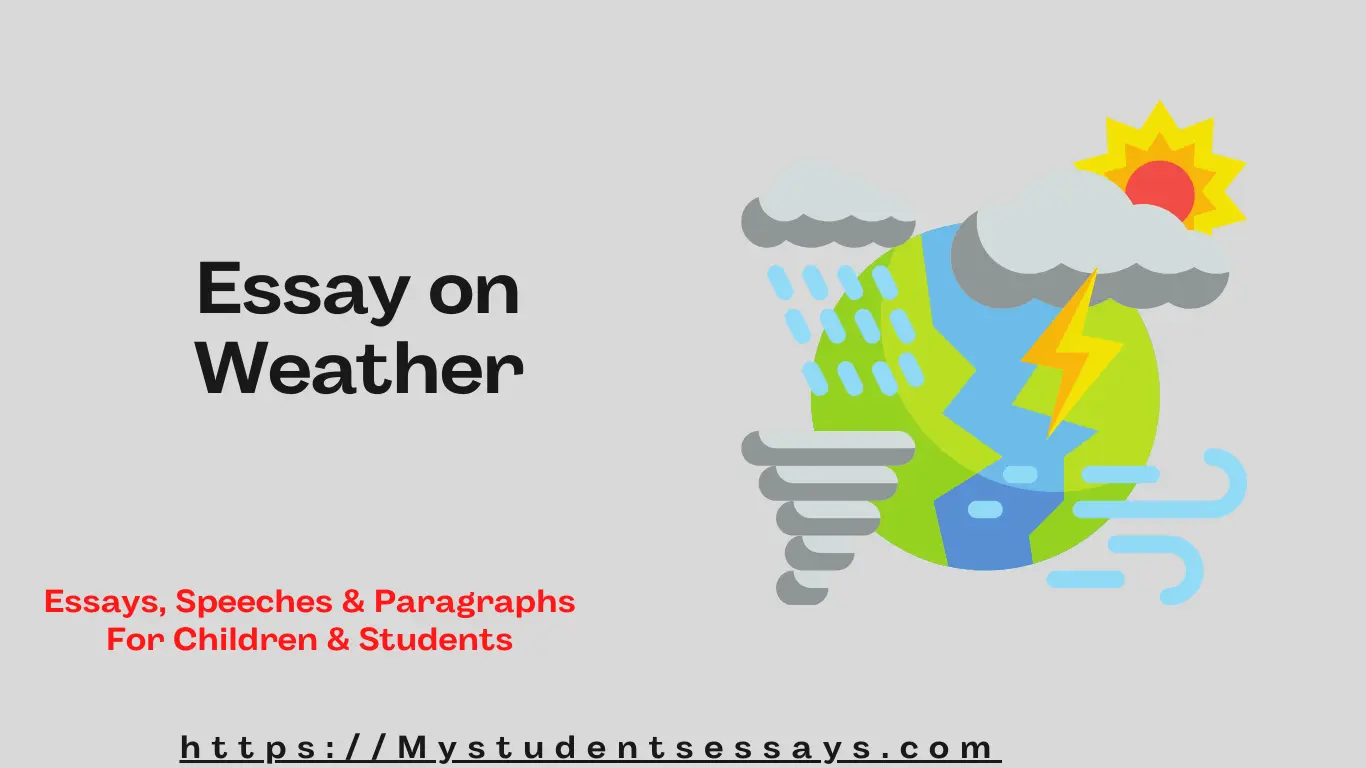

Essay on Weather [ Types, Importance in Life ]
Weather is the state of the atmosphere at a particular place and time. It includes temperature, humidity, precipitation, cloudiness, visibility, and pressure. The following Essay on Weather talks about its meaning and concept, types and how weather is important for us.
Essay on Weather | Types of Weather | Weather vs Climate
Weather is one of the most important aspects of our lives. It can have a huge impact on our mood, our health, and even our ability to function properly during the day. That’s why it’s so important to understand the different types of weather and how they can affect us.
Types of Weather
There are four main types of weather: sunny, cloudy, rainy, and snowy. Each type of weather has its own set of benefits and drawbacks.
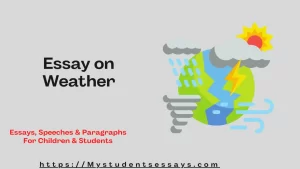
Sunny: Sunny weather is great for outdoor activities and spending time in the sun. However, it can also be very hot and dry, which can be dangerous for people with certain medical conditions.
>>>>> Related Post: ” Essay on Acid Rain “
Cloudy: Cloudy weather is cooler than sunny weather, but it can also be more humid. This type of weather is good for people who don’t like the heat but don’t want to deal with the cold.
Rainy: Rainy weather is perfect for activities that involve water, such as swimming or fishing. However, it can also be very muddy and wet, which can make it difficult to get around.
Snowy: Snowy weather is great for winter activities like skiing and sledding. However, it can also be very cold and dangerous for people who are not used to the cold weather.
Weather vs Climate:
Weather is the day-to-day condition of the atmosphere in a particular place, while climate is the average weather conditions in that place over a long period of time. Climate varies from place to place around the world. The climate in a tropical rainforest is very different from the climate in a desert.
Importance of Climate
Climate is important because it determines the types of plants and animals that can live in a particular place. For example, tropical rainforests have a very different climate from deserts. This means that different types of plants and animals can live in each environment.
Changes in Climate:
Climate change is a long-term shift in the average conditions of the atmosphere over a large area. Climate change could refer to a particular location or the planet as a whole. Climate change has been happening for millions of years, but it is only recently that humans have begun to impact the climate on a global scale.
Steps that we can take to Promote Healthy Weather
There are many things we can do to help promote healthy weather. Some of these steps include:
1. Reducing greenhouse gas emissions by using less energy and switching to renewable sources of energy 2. Protecting and restoring forests, which play a vital role in regulating the climate 3. Improving agricultural practices to reduce methane emissions from livestock 4. Conserving water to reduce the amount of energy needed to pump and treat it
Weather is an important part of our lives and can have a big impact on our mood, health, and ability to function properly. There are four main types of weather: sunny, cloudy, rainy, and snowy. Each type of weather has its own set of benefits and drawbacks. Climate is important because it determines the types of plants and animals that can live in a particular place.
>>> Related Post: ” Essay on Incredible India “
Climate change is a long-term shift in the average conditions of the atmosphere over a large area. There are many things we can do to help promote healthy weather, such as reducing greenhouse gas emissions, protecting and restoring forests, and improving agricultural practices.
Short Essay on Weather For Students:
Weather is the state of the atmosphere at a specific time and place. It includes various elements such as temperature, humidity, precipitation, wind, and air pressure. Weather plays an important role in our daily lives as it affects our activities and influences our mood.
Importance of Weather
Weather has a significant impact on human life. It affects agriculture, transportation, tourism, health, and even the economy. Farmers rely on weather conditions for their crops to grow while tourists plan their trips based on favorable weather conditions. Weather also has an effect on mental health as certain weather patterns can lead to seasonal affective disorder (SAD).
Factors Affecting Weather
The main factors that influence the weather are latitude, altitude, topography, and global air circulation patterns. Latitude determines the amount of sunlight received, while altitude affects temperature and precipitation. The shape of the land and presence of water bodies can also affect weather patterns.
Weather conditions can vary greatly depending on geographical location and time of year. Some common types of weather include sunny, cloudy, rainy, snowy, windy, hot, cold, and humid.
Sunny Weather
Sunny weather is characterized by clear skies with abundant sunshine. It usually occurs when high pressure systems dominate the area.
Cloudy Weather
Cloudy weather refers to a condition where the sky is covered with clouds blocking out the sun’s rays. This type of weather often occurs during low-pressure systems.
Rainy Weather
Rainy weather is characterized by precipitation in the form of rain. It can be caused by warm air rising and condensing into water droplets, which then fall to the ground.
Snowy Weather
Snowy weather occurs when temperatures are low enough for precipitation to freeze and fall as snow. This type of weather often brings hazardous driving conditions and can lead to school or work closures.
Windy Weather
Windy weather refers to a condition where there is a strong movement of air. It can be caused by differences in air pressure between two areas or by geographical features such as mountains.
Hot Weather
Hot weather is characterized by high temperatures and humidity levels. It can cause heat-related illnesses such as heatstroke and dehydration if precautions are not taken.
Cold Weather
Cold weather is characterized by low temperatures and can bring about freezing conditions, which can be dangerous for both humans and animals.
Humid Weather
Humid weather refers to a condition where there is a high level of water vapor in the air. It can make hot or cold temperatures feel even more extreme and uncomfortable.
Weather affects our lives in many ways, from influencing our daily activities to shaping our emotions. Understanding the different types of weather and the factors that influence them can help us better prepare for any changes in the forecast. As we continue to face the impacts of climate change, it becomes even more important to pay attention to the weather and take necessary precautions to protect ourselves and our environment.
How do you write a weather essay?
A weather essay typically begins with an introduction about the significance of weather, followed by a description of different weather phenomena, their impact on daily life, and any relevant data or statistics. It should also include personal observations or experiences related to weather and conclude with a summary or reflection.
What is weather in 100 words?
Weather refers to the atmospheric conditions in a specific place and time. It encompasses elements such as temperature, humidity, wind speed and direction, cloud cover, and precipitation. Weather can change rapidly and has a profound impact on daily life, agriculture, transportation, and various industries.
It is observed and forecasted by meteorologists using tools like weather stations, satellites, and computer models. Understanding and predicting weather is essential for planning outdoor activities, preparing for extreme conditions, and mitigating the effects of severe weather events like storms, hurricanes, and droughts.
What is weather in short notes?
Weather refers to the state of the atmosphere in a particular place at a specific time. It includes elements like temperature, humidity, wind speed and direction, cloud cover, and precipitation. Weather conditions can vary from day to day and even within hours.
Meteorologists study and forecast weather using various instruments and technology to provide information for planning activities, predicting severe weather events, and understanding climate patterns over time.
How do you start a weather paragraph?
A weather paragraph can begin by describing the current weather conditions in a specific location or by introducing the topic of weather in a broader sense. You can use attention-grabbing phrases or statistics to engage the reader’s interest.
Similar Posts
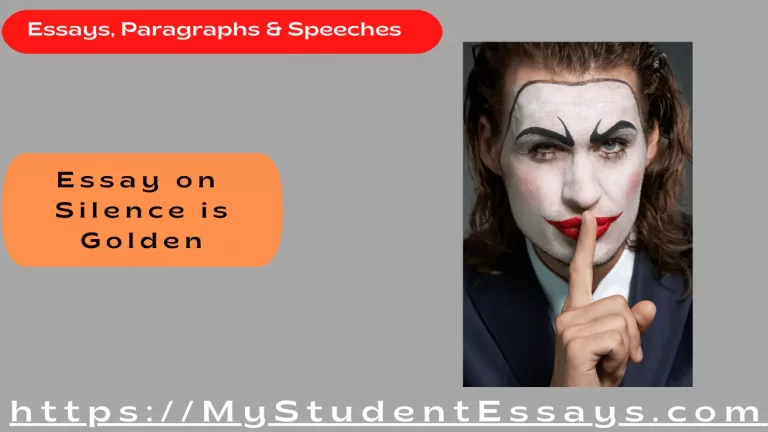
Essay on Silence is Golden For Students
When we talk about silence as golden we are referring to the virtues of being silent at sometimes in our Life. Most of the problems are somehow solved with us being silent. Silent as golden refers to the idea that being silent can actually be helpful and constructive in many ways. It gives us a…
![windy weather essay 12 Powerful Essays on Money [ Importance, Value, Power ]-2024](https://mystudentsessays.com/wp-content/uploads/2021/04/Essay-on-Money.webp)
12 Powerful Essays on Money [ Importance, Value, Power ]-2024
Money is really an important role player in our lives. But, we need to accept, money is not everything. Though money has the power, you can enjoy and afford every material luxury of life. But that is short lived. Money can’t bring real happiness, peace, certainty, power and freedom. We have written the following short…
Essays on Drug Addiction | Causes & Impacts of Drug Addiction in Youth
Drug addiction is the curse. It eats out the very fabric of our society. The following essay discusses the drug addiction with its underlying causes, its impacts and possible solutions for our youth. The essay is in simple language with easy to understand way. It would surely help primary, high school and college level students….

Essay on Personal Hygiene | Importance & Purpose of Personal Hygiene
Personal Hygiene is the practice of keeping oneself clean and free from germs and diseases. Personal Hygiene is very important for good health and to prevent illness. Practicing personal hygiene can help in preventing body odor, bad breath and other digestive disorders like constipation. The human body has various organs like the eyes, nose, ears,…
![windy weather essay 6 Best Essays on Hard work vs Smart Work [ 2024 ]](https://mystudentsessays.com/wp-content/uploads/2022/10/Essay-on-hard-work-vs-smart-work-768x432.webp)
6 Best Essays on Hard work vs Smart Work [ 2024 ]
Hard work is of great importance in life. However, there is a big difference between hard work and smart work. Hard work is simply working hard without thinking about the results. Smart work, on the other hand, is working hard with a goal in mind and taking action to achieve that goal. Essay on Hard…
![windy weather essay Essay on Shopping [ Importance, Skills, Shopping Tips ]](https://mystudentsessays.com/wp-content/uploads/2022/05/Essay-on-Shopping-768x432.webp)
Essay on Shopping [ Importance, Skills, Shopping Tips ]
Shopping is an activity or buying, assessing, analyzing or comparing products, goods and materials. The typical family shopping refers at the tasks of buying items or products from market for day to day use. The following essay talks about Shopping, meaning and history of shopping along with skills, tips needed for effective shopping in life….
Leave a Reply Cancel reply
Your email address will not be published. Required fields are marked *
Save my name, email, and website in this browser for the next time I comment.
160+ Ways to Describe Weather

I keep a collection of descriptions that have pulled me into the books I read. I’m fascinated how authors can–in just a few words–put me in the middle of their story and make me want to stay there. This one’s 160+ Ways to Describe Weather.
A note: These are for inspiration only . They can’t be copied because they’ve been pulled directly from an author’s copyrighted manuscript (intellectual property is immediately copyrighted when published).
- Evening shadows deepened into blue and purple.
- The shadows retreated.
- Sun was sinking toward the horizon, the pitiless white ball now an angry orange.
- Fading afternoon in early June
- Evening sky had turned to molten brass.
- Sun still cast a faint yellow light through Slowly gathering evening.
- Daylight had begun to drain away.
- one-quarter of a moonlit night
- silver-white moon hung
- A half-moon rests in the fronds over our heads.
- watching the horizon drain of color
- The shadows slipped up the rocks as though the world were drowning in darkness.
- deepening shadows made it a city of ghosts
- barely visible in the fading light
- the high heavens
- Darkness settled around him.
- The shadows slipped up the rocks.
- Evening was crisp already, the last of sunset just a fading pale stripe in the western sky.
- darkening river
- the moon golden at dawn, turn purple just before sunset in the rainy season, sometimes has white and black stripes created by volcanic ash, calm and clear sometimes attended by only a single cloud
- humpback shapes of conical hills
- The last rays of sun skimmed the surface.
- late afternoon sun
- velvety darkness
- night shattered like a mirror
- the Southern Cross lying on its side, the green meadow bathed in the humid light of the sinking sun
- The corners have just about disappeared into the shadows.
- black branches that traced the blue-black heavens overhead
- far away down the night sky
- full moon a pale blue-white disk
- night sky dull black
- Stars were remote pinpricks.
- a half-moon rests in the fronds over our heads
- inky blackness
- Thick clouds blotted out the stars.
- A thin layer of clouds masked the full moon, filling the room with blue light.
- Sun cast a luminescent glow.
- The day was out of sync with his mood.
- beautiful, 82 degrees, mild breeze, cloudless sunshine, a day for looking at a ball game
- The air was cool but the sun was out.
- The wind blew itself out overnight.
- a web of clouds, back-lit by the failing sun, mist billowed through the trees and over the fields and hung low in the air, masking the camp in a ghostly gray
- towering thunder clouds
- Clouds threatening, but no rain predicted the 45-mile per hour gusts of drizzly wind.
- brown cloud that passes for air
- a wedge of sunlight bursting past the narrow window
- The wind was icy and withering.
- Heads bowed against the gusting wind.
- Grit grated in his teeth. Dust was everywhere, blowing on the wind, leaving its scent in his nostrils.
- as dust motes drifted
- thirty miles over the horizon
- razor edge of the horizon
- cinder dust and gloom
- The haze floated over the crowd like smoke from a doused fire.
- Sun hanging in a pink haze of clouds and smog.
- Fog yellowed by agricultural burning.
- Fog began to billow across the road in a great grey mass like the effluent of a thousand smokestacks. The building was only a shadowy form, almost entirely lost to view.
- Headlamps of cars did little to pierce the gloom.
- The mist floated like smoke out of the cypress in the swamp.
- dark clouds drifting over the hills
- night was pitch
- slice of sky
- thick clouds blotted out the stars
- a thin layer of clouds masked the full moon, filling the room with blue light
- cool restful shady world with light filtering lazily through the treetops that meet high overhead and shut out the direct sunlight
- saw the anvil of cloud coming in. “A thunderstorm.”
- Cumulus clouds falling down to the…
- A light breeze whispered through the trees.
- cloud shadows
- first cumulus clouds darkening into thunderheads
- hold humidity like a sponge holds water
- thick heat of the growing morning
- fierce humidity
- windless heat
- It was surprisingly hot. He could feel the sweat roll down his sides and the dampness of the box up against his chest.
- Even with the breeze, the air remained thick and hot, and it stills tank of petroleum.
- sky as gray-white and sunless
- against the fading layers of orange, yellow
- shoulders hunched against the early morning damp and cool
- fused warm light of dawn now creeping down the summit
- bathed in sunlight
- gold shadow not three inches from his leg
- his breath steaming in the air
- Snow pelted his face and he pulled up the collar of his overcoat to further shield him from the bitter weather.
- rubbed his arms
- A harsh winter wind blew out of a midnight sky. It roared out of the frigid north and thrashed the brooking forest. The force of it bent trees, whipping their bare branches like angry lashes. Shrieking across the river.
- Cold was like that, seeping through her seven layers of clothing, attacking seams and zipper tracks and spots of thin insulation. The exposed skin on her face felt as if it had been touched with lit cigarettes.
- frigid Friday morning
- swirling snow
- winter’s naked branches created a black tracework
- The sun was climbing out of the deep well of winter, but it was still brutally cold.
- winter colors daubed the land in colors of brown and gray
- sunny, crisp and cool
- The crisp air and clear sky energized his thoughts.
Rainy weather
- grey wet morning
- rain-swept and unpleasantly chilly
- A flurry of rain stung my face.
- Cold rain was beating down on my windshield.
- The sky was leaden.
- Downpour started in the early evening and continued on through the night, a heavy pelting of water that thundered against rooftops and drowned out the sound of all else. By morning, city streets were shallow rivers rushing toward the ocean.
- Rain ran down the window, the streets gleamed.
- damp paving stones
- By the time it reaches the ground, it has spent its energy.
- windshield wipers barely keeping up with the cold, hard rain
- The rain came steady and cold against the windshield and rattled on the roof of the car.
- turned her head away and looked out my window, where it had gotten dark and shiny with the lights glistening off the rain.
- The maple trees were black and slick in the rain, their bare branches shiny. The flower bed was a soggy matting of dead stems.
- The sky was low and gray.
- Air was swollen.
- the rain was steady and warm and vertical
- drizzly rain
- The sleety rain drizzled down, not very hard and not very fast, but steady.
- Rain came down so hard it almost hurt, stinging the skin and blowing into the eyes and nose and mouth, but in the forest its fall is broken by the trees.
- saw a distant flash of lightning, counted the seconds, and then said, “six miles, more or less.”
People in hot weather:
- Heat wave hit, temperatures went soaring.
- The heat hit them like a hand in the face.
- strode into the dusk, into the stifling heat
- The heat smacked the grin off his face.
- Burst back into the blistering hot sun. Sweat immediately beaded across her brow. She could feel her T-shirt glue itself stickily to her skin.
- I could feel the sweat form along my backbone and trickle down.
- She slogged forward, feeling blotches of dark gray sweat bloom across the front of her T-shirt, while more trailed down the small of her back.
- slogging across pavement as hot as ash in August.
- white dress shirt, sharply pressed this morning, was now plastered against his chest
- already short of breath, his lungs laboring as they headed down the path
- still wrung out from working in the heat
- Take your shirt off. Pop your underwear in the freezer. Dump a tray of ice cubes on your bed. Throw back some chilled vodka shots before you go to sleep.
- The semi-drought slowly draining the life out of the grass and trees.
- Only 7 in the morning, and already stocky hot. *** had a sheen across his forehead.
- Sweat tricked from his forehead which he wiped with the back of his knotted, callused hand.
- hundred degree heat, burning sun and parching salt
- ninety-five outside, probably a hundred in the car. Not great weather for polyester suits
- a fresh drop of sweat teared up on her brow and made a slow, wet path down the plane of her cheek
- walking through a hair dryer
- The heat slammed her like a blow.
- *** cranked the air-conditioning. She stripped off her sweat-soaked clothes, climbed into the shower and scrubbed.
- answered the phone while used the other hand to wipe the sweat from the back of her neck. God this heat was unbearable. The humidity level had picked up on Sunday and hadn’t done a thing to improve since.
- *** thin green sundress was already plastered to her body while she could feel fresh dewdrops of moisture trickle stickily down between her breast.
- Cradled the phone closer to her damp ear
- Her face shiny with sweat.
- Summer sun remained a brilliant, blinding white. No shade existed for miles and the heat rising up from the baked earth was brutal.
- The summer heat came off the tarmac in waves.
Hot Weather
- While the mercury climbed to a hundred degrees. Efforts started strong, then petered out. People got hot, got tired, got busy with other things—inside things.
- Seemed to be bracing himself for leaving the cool comfort of air-conditioning behind and bursting once more into the heat
- The heat settled in on them, rolling in like a heavy blanket and pressing them deep into their chairs while their clothing glued to their skin.
- Even my teeth are sweating
- The sun beat down relentlessly; even with the AC cranked up, she could feel the heat.
- She could already feel sweat trickle down her back.
- The sun burned white-hot overhead.
- glass exploding from the heat of the sun
- vanish in the dry season’s brown leaves
Click for the complete list of 69 writer’s themed descriptions .
Copyright ©2022 worddreams.wordpress.com – All rights reserved.
Popular collections:
15 Ways to Describe Birds
How to Characterize Love in Your Writing
45 Transitions That Help Your Story Flow
Jacqui Murray is the author of the popular Man vs. Nature saga, the Rowe-Delamagente thrillers , and the acclaimed Building a Midshipman , the story of her daughter’s journey from high school to United States Naval Academy . She is also the author/editor of over a hundred books on integrating tech into education, adjunct professor of technology in education, blog webmaster, an Amazon Vine Voice , and a freelance journalist on tech ed topics. Look for her next prehistoric fiction, Savage Land Winter 2024
Share this:
- Click to share on Facebook (Opens in new window)
- Click to share on LinkedIn (Opens in new window)
- Click to share on Twitter (Opens in new window)
- Click to share on Pinterest (Opens in new window)
- Click to share on Tumblr (Opens in new window)
- Click to email a link to a friend (Opens in new window)
- Click to print (Opens in new window)
- Click to share on Reddit (Opens in new window)
122 thoughts on “ 160+ Ways to Describe Weather ”
Pingback: Top 10 Posts, Most Commented, Tips, and Share Platforms for 2023 |
Pingback: Top 10 Posts, Most Commented, and Tips for 2022 |
Pingback: How’s The Weather In Your Story? – Writer's Treasure Chest
Weaving words so perfectly – Thanks for sharing. And overnight, a transformation. Summer at last.,, .
Like Liked by 1 person
These really inspire me. I often read through my collections when I’m stuck.
helped my writing
Pingback: Top 10 Posts — and Most Commented — for 2021 |
Reblogged this on Coffee82 and commented: Awesome.
Like Liked by 2 people
Nice collection! A lot of poetic and inventive phrasing there.
✨🙏🕉🌱🌿🌳🌻💚🕊☯🐉✨
Weather is so many different things to different people. Not surprising I found 160 descriptions of it.
Ha! yes – that got me thinking about the old “Number of words for snow” question, and I found this . As a Scot myself though I have to say I am very, very skeptical of the final claim in that article!
I’ve heard of that, too. Luckily, my folks don’t have that problem but it is truly an issue if you’re writing about present-day groups in snowy lands.
Appreciate your list of ways to describe the weather. Timeless too. Here I am 2 years since your post and inspired by your creativity. Take care, Steve
It is timeless, isn’t it! When I put this list together, it helped me to better appreciate weather.
Impressive list. (Mine, now!) I’m compiling one for similes. Raymond Chandler makes me smile with his off the wall analogies. I recently added a Writing Terms Checklist on my free checklists page. It was too long for a post. Thanks for all you do!
I like checklists. I’ll check yours out!
Hi Jacqui, Thanks for reading my modest post. What an accomplished woman you are! What would we do without words, eh! Cheers. Joy x
Thanks, Joy. I enjoyed your thoughts. It’s amazing what inspired such accomplished writers as the Brontes.
Excellent list, Jacqui. I even get lots of ideas for titles, something I’m always struggling with entering competitions.
I grab these from books I read. You can probably tell I favor thrillers, action. I like ‘weather’ and ‘setting’ to be a character as much as the others.
That’s an amazing compilation. Thanks for sharing!!
Thanks! These sorts of lists inspire me.
An awesome post, Jacqui. Thank you. Weather intrigues. It is joy-filled and sometimes furious. God is bowling upstairs during a thunderstorm. Be well and enjoy the week. ox
Thanks–weather is fascinating. I like when I can feel it through an author’s words.
Indeed and thank you, Jacqui. Word play is an enjoyable activity. We have about seven months of winter, two days of spring and then summer at our end of the pond in Upstate New York. I love my four seasons. Be well.
7 months of winter. I didn’t know NY was that cold! Good to know so I never move there!
Jacqui, I laughed at your comment. We live near Lake Ontario and Oneida Lake and get frequent lake effect snow storms in winter. When I first moved to this area, I learned about lake effect snowstorms. We have excellent snow removal though so come on over sometime. Colorful in Autumn too.
Pingback: Episode 129: A Dark and Stormy Night – #WriteOnSC Radio Show and Craft School
These are great, Jacqui! And yes, inspirational. It’s good to see how other authors describe things; it gives ideas on alternates.
It is. There are some very clever minds out there.
What an epic list 😀 Reminds me of a ‘music’ video we were recommended to watch for university called ’50 words for snow.’ It’s fun to think of different ways to describe things!
That must be put out by Eskimos. They know more about snow than anyone I’ve seen.
That’s a long list, Jacqui. So many ways to tell the day. Thanks for sharing this!
It’s one of my longest! Who knew?
That’s a lot of ideas for talking about the weather 🙂
Dinner party chat.
Quite eloquent 🙂
These lists are so inspirational! Thank you for posting this.
It is pretty interesting to view weather through so many literary eyes, innit?
Yes, indeed. I learn so much. 🙂
great list Jacqui. i use the weather regularly in my stories to create a specific mood. thanks for the info.
A bit of unexpected inspiration. Who knew weather was so interesting?
exactly, Jacqui. i also post weather images regularly on instagram. especially the colours of sunrises and sunsets in clouds during different seasons and different weather conditions.
Interesting post, Jacqui. Thanks.
I highlight memorable phrases in the Kindle books I read. Although I no longer transcribe them into a file on my computer (too time-consuming), the mere act of highlighting imprints the phrases in my mind. If an author particularly impresses me, I can scroll through the highlights and reread the highlights for inspiration.
That’s how I do it, too. I like it so well, I’ve migrated from being a print book reader to a Kindle reader.
It’s nice to see the wide variety of language. Not that it is needy. I can describe the weather currently in my area in one word — sucky! 😀
Ah South Korea. It rained most of the time on my one visit there. And no one but me seemed to care!
We’re having a monsoon right now. Don’t remember having a good one of these for a while.
I remember my son telling me July was the typhoon season, which is why we visited in May. Stay safe!
Nothing that crazy. We had a tropical depression pass through, but that’s it. It’s just wet.
I love the idea of keeping a notebook with descriptions that catch your attention. I’m going to start doing this.
Mine is so long,d I added a table of contents with links to the sections! I’m a bit nuts about it.
Pingback: Author Inspiration and This Week’s Writing Links – Staci Troilo
I love the way you compile and share these lists with us, Jacqui. They are amazing and so helpful. Can I confess something? I share some of them with my creative writing students, and then give them prompts where they have to include 3 or more things from your lists. Will be interesting to see how I do that with weather. 🙂
This one got a little long. Who knew there were so many clever ways to describe weather?
I am flattered you share them! I would say weather could surprise them.
This one IS long – but weather gives us a lot to talk about and a lot to experience. I love the list. I will say, the prompt my students seem to love the best is. (are you sitting down?) “It was a dark and stormy night…” 🙂
Reblogged this on Marina Costa and commented: Interesting and useful to know.
Thanks for sharing, Marina!
The English should love this…
I would say India not so much. Do you-all get anything other than hot and humid or too-darn-windy?
What a helpful post, Jacqui! It reminds me of how we can put effort into our descriptions.
BTW, you won a book on my blog. Please confirm there.
Ooh, sorry I missed that. I just went over and replied and then emailed my info to you. How exciting!
Reblogged this on quirkywritingcorner and commented: I love her lists of descriptions. I hope you find them as helpful as I do.
Thanks for sharing this! It puts to bed any thought that weather is boring, doesn’t it?
That’s quite a collection, Jacqui. Isn’t it amazing that each of us can conjure something unique?
It is! Next time you don’t know what to say to someone, you can eruditely talk about the weather!
That’s so funny. Weather ‘small’ talk. Who would’ve thought. 😂
Great post. That’s a wonderful collection
Thank you so much, Luisa. It’s hard to make weather interesting but some very clever authors have done just that.
Jacqui, I love this post. The more I have been reading, the more I recognize how important it is for authors to paint a picture in your mind. To be able to put you right in the middle of the books setting. Sometimes when my mind has trailed off the story, it is descriptions like these that put my mind right back in.
That’s true, innit. A little inspiration to start your day.
I love your descriptions of weather and the times of day. Such descriptions can help add a sense of time in a story (just as the phases of the moon or the stars can create time (crescent moon in evening is aa new waxing moon, crescent moon in morning before sunrise is a waxing moon just before the “dark of the moon” which are the three days the moon is in the shadow of the earth. As for stars: Orion in winter, Scorpus in summer, etc). The dog star in Canis Major, Sirius, the brightest star in the sky, rising in late summer (as it rises just before daylight) is linked to “dog days” of summer…
I also like the old graveside prayer that describes the end of life: “until the shadows lengthen and the busy world is hushed, and the fever of life is over, then in thy mercy grant us a safe lodging and a holy rest and peace at last.”
What a wonderful poem. I’ve copied it. It captures so much of the fear and hope.
Thanks for these awesome examples, Jacqui! Saving and sharing…
It’s always fun to talk about the weather, innit?
New Jersey weather: moist ‘n’ icky.
Good description, especially the ‘icky’.
I calls ‘em like I sees ‘em.
Oh my, Jacqui. I love your lists and that’s a good long one. Great thought starters. Thanks for sharing your collection!
Since we-all know we must cover weather, I thought these were clever asnd interesting ways to do that!
Ha ha ha. I love weather. 😀
Right now there is only one way to describe the weather here in my city: hot
Here, too, though I have an excellent fan in my home office.
Some great phrases here, Jacqui. I am reading The Long Walk by Bachman/King at the moment and that has some very descriptive phrases in it.
Oooh, I’ll have to look at him. I love nature writers.
It’s not a nature book, it is a dark psychological horror.
Woah! OK, that’s different!
Darn! All the things I was about to write! 😀
Hehee. These are beyond most of what I write but I’ve seen what you turn out. Excellent.
Wonderful post!
Thanks, Ed. Food for thought…
A lot, just wonderful and so helpful.
My goodness …. can I just say ‘HOT’ … luckily today it’s cooler with a sea breeze … I need to read them all – clever and thank you! Cheers Hilary
Hot works. Absolutely.
Hahaha can I just say HOT, or the weather outside is weather yeah?
What a wonderful list, Jacqui! These are descriptions that always make me pause and reread them to fully enjoy them. They do draw the reader deep the story. I enjoyed reading these, thanks:)
Thanks! They do that for me, too, and that’s why I couldn’t just read and move on. I had to note them!
Some of these are quite lovely. Thanks for sharing.
If you recognized them from your outdoors scenes, feel free to add a note!
I actually didn’t recognize any of them. 🤔
OMG, Jacqui. What an amazing list Thanks for sharing.
It’s really nice for those whose plots take place outdoors a lot!
BTW, finished your book. Couldn’t stop reading. Wonderful.
Thank you, Jacqui. You put a smile on my face:)
Wow, great post. Bookmarking.
Amazing how much there is to say about the weather, innit?
I love weather, the seasons, earth and sky. There were some lovely gems in this collection. Thanks for sharing.
Thanks, Mae. I didn’t used to think much about the weather until I had to write about it, and make it interesting! These really struck me.
A terrific resource Jacqui. Thank you.
Thanks so much, Brigid. I couldn’t believe how many weather descriptors I had!
Nice information thanks
Thanks! Everyone writes about weather, right?
Great list, Jacqui. Thanks so much for sharing.
Thanks, Jill. Who says weather isn’t interesting? Hmm??
I think I’d like to be a meteorologist in my next life. 🙂
Reblogged this on chrismakan .
Thanks for sharing!
Wow this is very educative
I love how some writers weave their words so perfectly.
What do you think? Leave a comment and I'll reply. Cancel reply
This site uses Akismet to reduce spam. Learn how your comment data is processed .
- Already have a WordPress.com account? Log in now.
- Subscribe Subscribed
- Copy shortlink
- Report this content
- View post in Reader
- Manage subscriptions
- Collapse this bar

BRYN DONOVAN
tell your stories, love your life
- Writing Inspiration
- Semi-Charmed Life
- Reading & Research
- Works In Progress.
Master List for Describing Weather
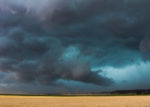
A lot of writers struggle with describing settings. I’ve written before about how to describe settings and why it matters , but a few people have told me they’d like me to do some of my master lists for writers to help them out!
I have a weird love for creating lists like this, so I’m happy to do it. “How to describe weather” seemed like a good place to start. This way, you won’t get stuck trying to figure out how to describe nice weather, or thinking up ways to describe rain. Hopefully, this will make your writing go faster.
I always include simple as well as more creative ways to describe or write about weather. Sometimes, the simple word is the one you want! I included dryness and humidity in a few of the categories because it felt weird for them to get their own.
As always, this is not a comprehensive list, and I might add to it. My list will probably make you think of other possibilities, too. Bookmark or pin it for future writing reference!
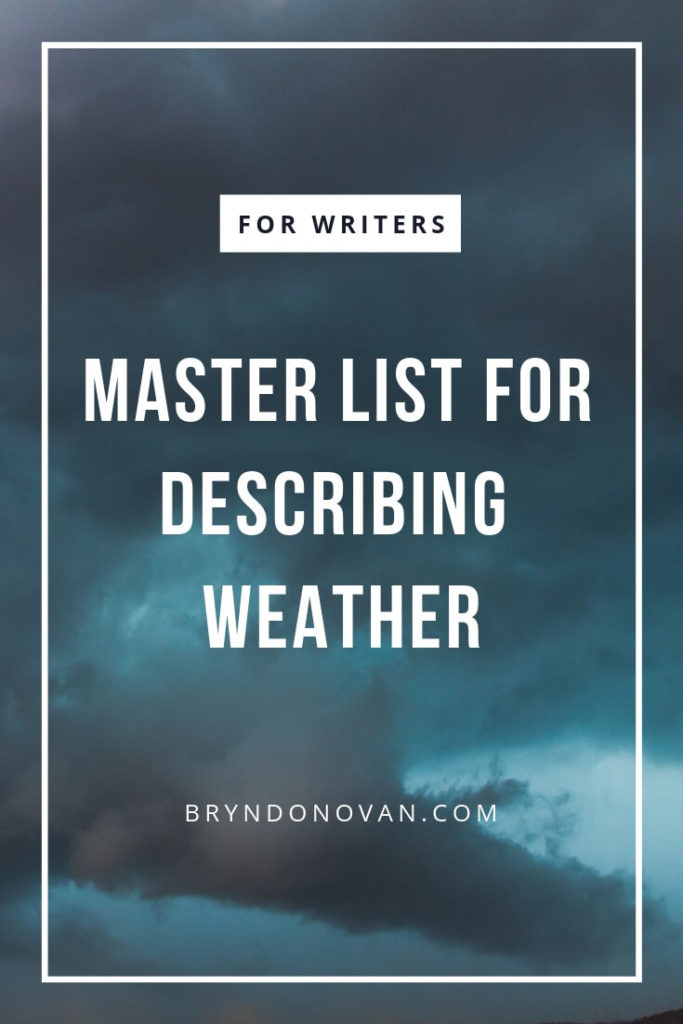
HOT WEATHER

blazing sunshine
glaring sun
baking in the sun
sun-drenched
scorching heat
extravagant heat
relentless sun
like a suana
dense tropical heat
radiating heat
blistering heat
oppressive heat
insufferable heat
suffocating heat
heat pressing down
searing sun
shimmering heat
like an oven
like a furnace
WARM / PLEASANT WEATHER

(“Pleasant” is a matter of opinion, of course.)
a beautiful day
a clear day
a temperate day
a golden day
a glorious day
heavenly weather
bright and sunny
a gorgeous spring day
a dazzling summer day
a brilliant autumn day
a vivid blue sky
a cloudless sky
fluffy white clouds
gentle sunshine
lazy sunshine
kind sunshine
filtered sunlight
dappled sunlight
welcome warmth
one of those rare, perfect days
the kind of day that made people forget to worry
the kind of day that lifted people’s moods
COOL WEATHER

refreshing air
stimulating cool air
invigorating cool air
bracing cool air
a nip in the air
a brisk day
a chilly day
weak sunshine
GRAY / OVERCAST WEATHER

(Most people don’t like gray days, so most of these descriptions are negative. I love them, so I had to add a few positive descriptions.)
colorless sky
a soft gray sky
a dove-gray sky
a gray day made for books and tea
steel-gray sky
granite sky
cement-gray sky
threatening clouds
foreboding clouds
COLD WEATHER

glacial air
bitter cold
brutal cold
bone-chilling cold
penetrating cold
devastating cold
numbing cold
punishing cold
dangerous cold
unforgiving cold
too cold to talk
so cold it burned one’s lungs
so cold it took one’s breath away

like a blast from a hair dryer
a gust of wind
insistent winds
heavy winds
strong winds
cutting wind
whipping winds
biting wind
wintry squall
violent gale
howling wind
shifting winds
restless wind
fresh breeze
soft breeze
balmy breeze
perfumed breeze
slight breeze
hint of a breeze
stirring breeze
wind rustling through the trees

fine drizzle
gray drizzle
pebbles of falling rain
spitting rain
stinging rain
steady rain
rain falling in torrents
cascades of rain
rain beating down
shower of rain
sheets of rain
hard-driving rain
pelting rain
lashing rain
slashing rain
THUNDER AND LIGHTNING

rumbling in the distance
a roll of distant thunder
crash of thunder
crackle of thunder
crack of thunder
clap of thunder
bang of thunder
booming thunder
rattled with thunder
earth-shaking thunder
tempestuous
a furious storm
flash of lightning
streaks of lightning
SNOW AND ICE
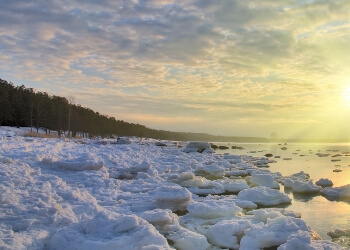
flurries of snow
dancing flakes
snowflakes floating down
snowflakes wafting down
swirling snow
falling thick and fast
big flakes falling like petals
blinding snowstorm
raging blizzard
sparkling expanses
blankets of white
caked with snow
boulders of snow
branches coated in ice
glittering ice
crystallized by frost
silvered with frost

clouds of mist
swirling mist
billowing fog
cloaked in mist
cocooned in fog
shrouded in fog
enveloped by fog
smothered by fog
made mysterious by fog
the fog rolled in
the fog was burning off
the fog was lifting
the fog was clearing
the fog was dissipating
I have many lists like this in my book Master Lists for Writers: Thesauruses, Plots, Character Traits, Names, and More . Check it out!

Do you describe weather conditions in your writing? Do you have a favorite example of a weather description? Let me know in the comments! Thanks for reading, and happy writing!
[spacer height=”20px”]
Related Posts
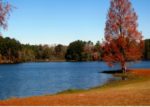
Share this:
21 thoughts on “ master list for describing weather ”.
In my current WIP, weather is a crucial element. Not only is the woman in the romance a professional photographer — of weather — but it is a weather phenomenon, namely a tornado, that brings them together. So the description of the sky and the weather is quite detailed in places (specially as the supercell storm roars down on them).
On another angle, the phrase “gloriously sunny” is one that despite having that horrible “ly” adverb (shudder) is so evocative of the type of weather and the POV character’s attitude (and possibly even the type of weather that has gone before), that it’s powerful. It says a huge amount with only two words.
Hi Chris! Oh, wow…that’s a lot more detailed than most of us ever get in writing about the weather. It sounds like a great premise!
I will need this list as I begin edits next month on my WIP. I currently live in Hawaii, but am writing a story at Christmas time in Vermont. 🙂 Thank you!
Aw, nice! That’s some very different weather from what you’re used to. 🙂
It really is! And traveling to the climate I need isn’t ideal right now. So, off to the freezer I go! 🙂
Wow! This is fantastic. Thanks. You ARE a master at this.
- Pingback: Master List for Describing Weather – Written By Bryn Donovan – Writer's Treasure Chest
This is comprehensive! It’s bookmarked for future use. Thanks!
Thanks, Steve, I’m glad you liked it!
Amazing list that goes beyond the words that I struggle with – especially describing the rain-painted setting of Snowdonia.
Love your lists. You don’t have one for beaches by any chance? Would this, including the weather be another book by any chance??
Hi, Nicole! It’s funny you should ask. 🙂 I am going to release a second, more expanded version of MASTER LISTS FOR WRITERS . It’s going to have several setting descriptions in there (including a whole list for beaches!), and the weather list will be in there, too! I’m hoping to get it done before November of this year, but we’ll see. Thanks for asking!
That’s awesome and look forward to it’s release.
- Pingback: ? Writing Links Round Up 7/1-7/5 – B. Shaun Smith
- Pingback: How to Write a Novel: Resources - MultiTalented Writers
- Pingback: ? Writing Links Round Up 8/19-8/23 – B. Shaun Smith
I am in Chinan. I happened to enter this web-link and want to learn more about writing, I wonder if there are any descriptive passages. I can only find some words and expressions…
That was really useful. Thank you!
- Pingback: The Power of Vision in Writing | Writers In The Storm
This list is fabulous. Thank you for sharing it. I will be consulting it when incorporating weather elements into writing my next picture book.
- Pingback: How’s The Weather In Your Story? – Writer's Treasure Chest
Leave a Reply Cancel reply
This site uses Akismet to reduce spam. Learn how your comment data is processed .
Discover more from BRYN DONOVAN
Subscribe now to keep reading and get access to the full archive.
Type your email…
Continue reading
Beginning A Composition With Weather Descriptions
- Sunday, Sep 9th, 2018
- By: BIG IDEAZ
- Composition Framework
- Writing Techniques
Estimated reading time: 5 minutes
Weather description is one of the easiest ways for young writers (6 to 8 years old) to begin their compositions. This is also usually the first story starter that they are being taught in school.
For children who are weak in the language, writing a good weather description can be an easy and effective way to get them started in their composition.
However, most teachers do not encourage flowery weather descriptions such as these:
“White fluffy clouds dotted the azure blue sky as the sun beamed beatifically, casting a golden glow upon the earth.”
“The sky was an expanse of sapphire blue, dotted with feathery white clouds as the radiant rays of the sun shone brightly in the azure blue sky.”
You get the picture.
Proper Use of Weather Descriptions in English Compositions
Weather descriptions is an easy way for young writers to begin their stories. Primary 1 and 2 students can start their compositions with weather descriptions, if weather plays a part in the plot.
There is no need to memorise a hugh chunk of bombastic weather descriptions.
Simple words can sometimes be more effective than bombastic ones.
These are some of the weather descriptions written by our P1 and P2 students:
“It was a cool and breezy evening. A strong gust of wind blew against my face.”
“It was a bright and sunny morning. White, fluffy clouds drifted across the sky.”
“Lightning flashed across the sky. A storm was coming.”
Short. Simple. Readable.
The kids came up with these weather descriptions themselves, without memorising any bombastic phrases.
Most importantly, they are natural, something which children can understand, remember and apply in their writing.

Get this set of PSLE Model Compositions with writing techniques highlighted.
So, how can children be taught to write weather descriptions?
For children who are really weak in the language, even writing a simple sentence to describe a sunny day can be difficult. These children often resort to starting their compositions with “One day, we went…” or “One fine day, Peter was …” or “Last Sunday, my family and I …”.
Such story beginnings can be boring and not captivating.
Students can learn to write effective weather descriptions. In our classes, we get our students to do brainstorming.
1. Brainstorm and make a list of all kinds of weather that you can think of.
- cold and rainy
- cool and breezy
- bright and sunny
- scorching hot
2. For each weather type, imagine how the sky, sun, clouds and other weather elements look like.
Describe each element in simple, readable English .
Weather Type: BRIGHT AND SUNNY
Describe the sun: – shines brilliantly – bright – like a fire ball
Describe the sky: – clear, blue sky
Describe the clouds: – white, fluffy clouds – sunlit clouds
3. Form sentences using some of these descriptions.
It was a bright and sunny day. The sun shone brilliantly in the clear, blue sky .
It was a bright and sunny day. White, fluffy clouds drifted across the clear, blue sky .
The above 3 steps are effective in teaching young children (Primary 1 to 3) to come up with weather descriptions that sound natural. Most children are able to come up with beautiful weather descriptions without resorting to the method of memorising huge chunks of unreadable flowery language.
Download the FREE Brainstorming Sheet for Weather Description
Use Weather Descriptions Appropriately
Some students have the habit of starting every composition with weather descriptions, regardless of topic or setting. Remember to use weather descriptions only if weather plays a part in your story. For example, if a rainy weather contributes to the plot of the story, it is a good idea to describe the weather, especially the rain and the coldness. If a story is set outdoors, it is fine to describe the weather too.
However, many students fell into the trap of starting their compositions with describing the sun, the clouds and the sky when their story is set indoors! This is a huge mistake, which should be stopped.
Other Types of Story Beginnings
For stories which are not set outdoors or not affected by the weather, there are other types of story beginnings that can be used.
Students can begin their compositions with speech , which is also a common way of beginning a primary school composition.
Another effective way is to begin with a captivating statement or an intriguing question. Such a beginning hooks readers immediately to read on. When used correctly, it piques a reader’s curiosity and make them want to continue reading to find out what happens next.
Upper primary students can begin their stories with character descriptions . This is useful to show a change in the character at the end of the story. For example, a timid person who became courageous, or a bully regretting his actions and turning over a new leaf.
Beginning with an action is great if you want to move the story along quickly. Students can use suitable vivid verbs to clearly describe a character’s actions at the beginning of the story.

Get our FREE pack of 300 vocabulary cards that your child can use in his or her compositions.
Writing is a skill that improves with practice.
Enrol in our highly popular Writing Academy or Junior Writing Academy , our online courses that support primary school students in developing their English composition writing skills.

Related posts:
Author: BIG IDEAZ
Click on the icon below to chat on WhatsApp or email us at [email protected] or self-help with our FAQs .
Prompt response during working hours on weekdays/Saturdays.

Describe The Weather In Writing With Better Vocabulary
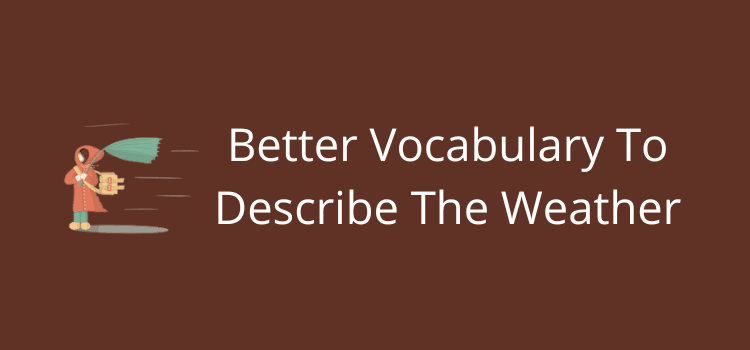
When you describe the weather in writing, you set the scene for your story or a part of your story.
It’s an opportunity to show readers the setting rather than tell them about the weather using a couple of quick adjectives.
Using highly descriptive or figurative language and a variety of grammar structures helps you paint the picture vividly in a reader’s mind.
In almost every story, both fiction and nonfiction, there is usually at least one reference to the weather.
In This Article
How to describe the weather in writing
We all know this famous opening line from Edward Bulwer-Lytton’s 1830 novel, Paul Clifford.
It was a dark and stormy night.
Many have criticized the phrase, and Writer’s Digest went as far as to call it the literary poster child for bad story starters.
The main issue is that it uses two very weak adjectives: dark and stormy. Neither of them is usefully descriptive.
The second problem with the phrase is that it starts with a grammatical expletive .
When writing about the weather, using it was, or there was is a common writing fault. It’s because we so often refer to the weather as it.
But few people take into account what follows Bulwer-Lytton’s famous clause. It’s a pity because the complete sentence is a wonderful example of how to describe the weather in writing.
It was a dark and stormy night; the rain fell in torrents—except at occasional intervals, when it was checked by a violent gust of wind which swept up the streets (for it is in London that our scene lies), rattling along the housetops, and fiercely agitating the scanty flame of the lamps that struggled against the darkness.
He uses descriptive noun phrases , strong verbs, and powerful adjectives.
The combination of these three elements paints a vivid picture for readers.
Choosing your vocabulary

You can find many lists of common and unusual words to describe the weather, so you have plenty of choices.
But you should avoid words that are too simplistic. It was hot, cold, windy, or rainy are all very weak expressions.
But if you describe the heat, the cold, the wind, or the rain with noun phrases, you can improve these easily.
The sun started baking early across the plains, delivering a scorching promise for the day ahead.
The cruel icy wind cut like a knife across her cheeks.
Rain, as always, arrived too little, too late to save the crops.
Words that are not widely understood are also worth avoiding. While it’s interesting to find new words, not all of them are useful.
A good example is petrichor. It is the smell or scent of rain arriving after a period of dry weather.
But it is difficult to use, and it might send readers hunting for a dictionary.
The petrichor gave a hint of hope to the farmers.
It would be better to use a descriptive phrase.
The sweet far off scent of rain on dying grass gave hope to the farmers.
Brontide is another, meaning the sound of distant thunder or rumblings of an earth tremor. Again, it’s a great word to know, but with very limited use in writing.
Try this simple formula
Anytime you need to write about the weather, keep this little trick in mind.
Start with a noun phrase, use a strong verb , then add a descriptive clause .
You also need to describe the noun and verb with adjectives and adverbs.
Here’s a quick example.
The heavy dark clouds rolled slowly and low across the parched pastures, but they were heartbreakers, as not a drop of rain fell before the cruel wind carried them away.
It’s an easy way to make sure you avoid the grammatical expletive and weak adjectives.
You can also experiment with similes or metaphors . For example, raining cats and dogs.
Use verbs that sound like the weather

Onomatopoeic verbs and words are perfect for describing the weather because they make a sound.
Here are a few examples to illustrate sound words.
The pitter-patter of raindrops.
Thunder rumbled overhead.
Light hail pinged on the window pane.
With each step, the fresh snow crunched underfoot.
A bolt of lightning cracked across the night sky.
A cold north wind hissed through the trees.
A sudden boom of thunder forewarned us of the approaching storm.
Verbs and words like these are extremely useful because they are action words and highly descriptive.
This article is not a lesson or lecture on how to describe the weather in writing.
It’s purely a reminder that you can always improve.
I have listed a few ideas above, but there are many more ways you can make the weather more interesting.
All it takes is to remember that the setting for a scene or a story needs careful thought and imagination.
But if there are two key takeaways from my article, they are these.
1. Avoid using the grammatical expletive when referencing the weather.
2. Use noun phrases and strong verbs.
If you do those two things, the rest of your weather scene setting will come very easily.
Related reading: Words To Avoid In Writing That Say Nothing
About The Author
Derek Haines
More articles.
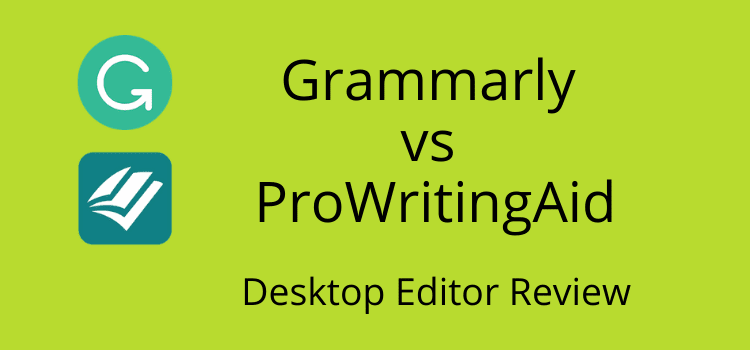
Prowritingaid And Grammarly Desktop Editor Review
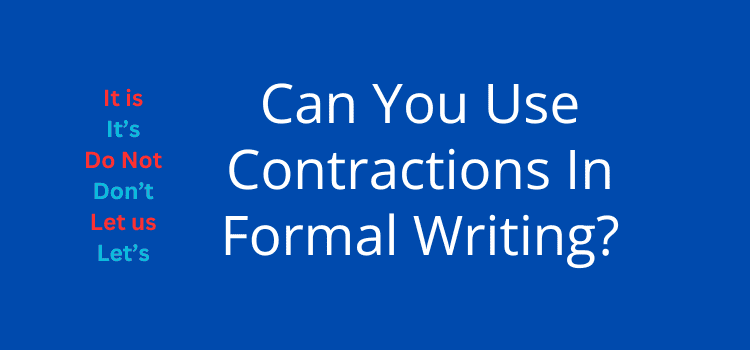
Contractions In Formal Writing – No, Yes, Perhaps?

The Writing Tools And Software I Use Now Are Usually Free
Leave a comment cancel reply.
Your email address will not be published. Required fields are marked *
Save my name, email, and website in this browser for the next time I comment.
To prevent spam, all comments are moderated and will be published upon approval. Submit your comment only once, please.
This site uses Akismet to reduce spam. Learn how your comment data is processed .
Privacy Overview
Sciencing_Icons_Science SCIENCE
Sciencing_icons_biology biology, sciencing_icons_cells cells, sciencing_icons_molecular molecular, sciencing_icons_microorganisms microorganisms, sciencing_icons_genetics genetics, sciencing_icons_human body human body, sciencing_icons_ecology ecology, sciencing_icons_chemistry chemistry, sciencing_icons_atomic & molecular structure atomic & molecular structure, sciencing_icons_bonds bonds, sciencing_icons_reactions reactions, sciencing_icons_stoichiometry stoichiometry, sciencing_icons_solutions solutions, sciencing_icons_acids & bases acids & bases, sciencing_icons_thermodynamics thermodynamics, sciencing_icons_organic chemistry organic chemistry, sciencing_icons_physics physics, sciencing_icons_fundamentals-physics fundamentals, sciencing_icons_electronics electronics, sciencing_icons_waves waves, sciencing_icons_energy energy, sciencing_icons_fluid fluid, sciencing_icons_astronomy astronomy, sciencing_icons_geology geology, sciencing_icons_fundamentals-geology fundamentals, sciencing_icons_minerals & rocks minerals & rocks, sciencing_icons_earth scructure earth structure, sciencing_icons_fossils fossils, sciencing_icons_natural disasters natural disasters, sciencing_icons_nature nature, sciencing_icons_ecosystems ecosystems, sciencing_icons_environment environment, sciencing_icons_insects insects, sciencing_icons_plants & mushrooms plants & mushrooms, sciencing_icons_animals animals, sciencing_icons_math math, sciencing_icons_arithmetic arithmetic, sciencing_icons_addition & subtraction addition & subtraction, sciencing_icons_multiplication & division multiplication & division, sciencing_icons_decimals decimals, sciencing_icons_fractions fractions, sciencing_icons_conversions conversions, sciencing_icons_algebra algebra, sciencing_icons_working with units working with units, sciencing_icons_equations & expressions equations & expressions, sciencing_icons_ratios & proportions ratios & proportions, sciencing_icons_inequalities inequalities, sciencing_icons_exponents & logarithms exponents & logarithms, sciencing_icons_factorization factorization, sciencing_icons_functions functions, sciencing_icons_linear equations linear equations, sciencing_icons_graphs graphs, sciencing_icons_quadratics quadratics, sciencing_icons_polynomials polynomials, sciencing_icons_geometry geometry, sciencing_icons_fundamentals-geometry fundamentals, sciencing_icons_cartesian cartesian, sciencing_icons_circles circles, sciencing_icons_solids solids, sciencing_icons_trigonometry trigonometry, sciencing_icons_probability-statistics probability & statistics, sciencing_icons_mean-median-mode mean/median/mode, sciencing_icons_independent-dependent variables independent/dependent variables, sciencing_icons_deviation deviation, sciencing_icons_correlation correlation, sciencing_icons_sampling sampling, sciencing_icons_distributions distributions, sciencing_icons_probability probability, sciencing_icons_calculus calculus, sciencing_icons_differentiation-integration differentiation/integration, sciencing_icons_application application, sciencing_icons_projects projects, sciencing_icons_news news.
- Share Tweet Email Print
- Home ⋅
- Science ⋅
- Nature ⋅
- Environment
How Does Wind Affect Weather?

Do Winds Always Blow From High Pressure to Low Pressure?
Weather is the day-to-day fluctuation of temperature, moisture, and wind currents. It is driven by nuclear energy received from the sun. As the oceans and continents as well as atmospheric elements like methane and carbon dioxide heat up or cool down, high and low temperatures create atmospheric pressure, resulting in wind or the air movement of atmospheric constituents like water vapor, dust, and gases.
Earth's Tilt and the Sun
Over approximately 40,000 years, the Earth's axial tilt ranges from 22.1 degrees to 24.5 degrees. As the angle of the Earth in respect to the sun changes, so too does the available energy received from its nuclear furnace. The current axial tilt of roughly 23.4 degrees creates six major wind belt zones divided by five lines of latitude. As the Earth orbits the sun, the angle of the sun's rays changes across the globe as a direct result of the Earth's axial tilt.
As the rays of electromagnetic energy from the sun enter the Earth's atmosphere, they are either reflected back out to space, absorbed by atmospheric gases or stored in ocean waters or continental surfaces. The closer the ray's angel of entry is to 90 degrees, the greater the amount of energy that is retained. As a result, latitudes nearer the equator receive more of the sun's energy throughout the year than do higher and lower latitudes.
The equator, at 0 degrees latitude, divides the northeast trade wind zone in the Northern Hemisphere from the southeast trade wind zone in the Southern Hemisphere. In respect to the wind belts, the equator is known as the equatorial doldrums. The horse latitudes are located at 30 degrees north latitude and 30 degrees south latitude, and divide the northeast and southeast trade wind zones from the zones known as the prevailing westerlies.
Above and below the prevailing westerlies at 60 degrees north latitude and 60 degrees south latitude are the polar fronts dividing the prevailing westerlies from the polar easterlies.
Wind Belts and Wind Direction
Simply put, the direction of wind flow associated with wind belt zones flows from the direction indicated within its name. The northeast trade winds flow from northeast to southwest. The southeast trade winds flow from the southeast to the northwest.
The Coriolis Effect
If it were not for the Earth's rotation, the winds would simply flow in relatively straight paths from north to south or from south to north respectively. But the Earth does rotate, and as a result, the wind and weather patterns are deflected to the right in the northern hemisphere and to the left in the southern hemisphere.
This effect is known as the Coriolis effect and adds greatly to the atmospheric airflow mixture and weather variability.
Sea and Canyon Breezes
Localized winds like those found along a coastline are created by similar forces. As the sun rises, the water and the land absorb the sun's heat at different rates. As a result, high and low pressure systems are created. In the morning, the land will heat up faster than the water. As the land heats up it, radiates heats to the surrounding area.
Hot air is less dense than cold air, so the warming air begins to rise, pulling the cooler air over the water inland. As the heated air rises, it begins to cool, flowing out to sea until it grows cold and dense and falls. This cycle reverses as the day closes and sun begins to set.
Not only does the land warm faster, but it also cools faster than does water. As a result, the circle of air flow reverses as the warmer air above the water flows toward the cooler air above the land.
Wind and Weather
As a result of the movement of atmospheric materials transported by wind, driven by the energy from the sun, climates are created and weather occurs. Without wind, weather would not exist. Wind, in its interdependent relationship with the other cycles of the Earth, like ocean currents, is the vehicle by which water vapor and, by consequence, temperature variations are moved from one area of the globe to another, creating weather variations within specific climate zones.
Related Articles
The four forces that influence wind speed & wind direction, what causes the clouds of a hurricane to spiral, how do air currents work, how does latitude affect climate, characteristics of an intertropical convergence zone, hadley cell effects, what are the doldrums, the effects of revolution & rotation on climate & weather, the climate on the planet mercury, how does wind work, what causes the differences in pressure that result..., what causes wind direction, how are winds formed, how is the sun nuclear energy, five parts of the climate system, how is wind direction determined, what causes convection currents on the mantle, two types of planetary motion, the geology of the earth's internal processes.
- Weather Works: How Does the Wind Impact Temperatures?
- National Oceanic and Atmospheric Administration: Weather Systems and Patterns
- WW2010 University of Illinois: Global Wind Patterns
About the Author
JL Wilson has worked in the construction industry for nearly 20 years. During that time, he labored as a carpenter, cabinetry door and millwork foreman, installer, designer, and account manager. He has designed, built, and installed projects as simple as a single jewelry box and as complicated as integrated swimming pool/waterfall complexes. Wilson primarily writes for eHow and Answerbag.
Find Your Next Great Science Fair Project! GO

A Writer’s Guide to Describing Wind: Top Words & Examples

Affiliate Disclaimer
As an affiliate, we may earn a commission from qualifying purchases. We get commissions for purchases made through links on this website from Amazon and other third parties.
Describing weather is an essential part of creating a vivid and immersive setting in writing. Wind, in particular, can add an extra layer of depth to a scene, whether it’s a gentle breeze or a howling gale. However, finding the right words to describe wind can be challenging for writers. That’s why this article aims to provide a comprehensive guide to describing wind, complete with the top 100 words and examples.
As a writer, it’s important to understand the impact that weather can have on a story. Wind can create tension, set the mood, and even influence character behavior. Describing wind in a way that accurately conveys its effects on the environment and characters can help readers fully immerse themselves in the story . This guide will provide writers with a range of descriptive words and examples to help them effectively convey the presence of wind in their writing.
Whether you’re a seasoned writer or just starting, this guide will provide you with the tools you need to create a compelling and immersive story. By using the right words and examples to describe wind, you can transport your readers to a world where they can feel the breeze on their skin and hear the rustling of leaves. So, let’s dive into the top 100 words and examples for describing wind and take your writing to the next level.
The Role of Weather in Narrative
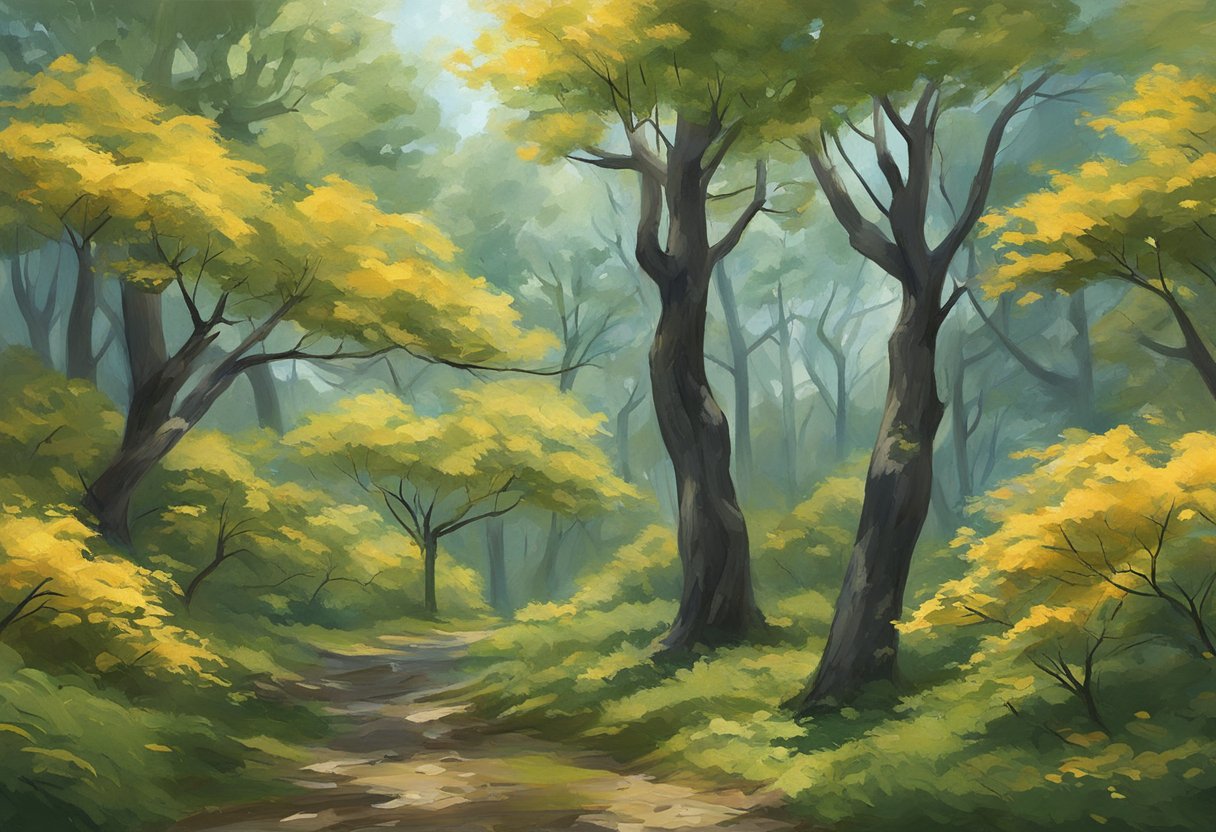
Weather is an essential aspect of storytelling, and it can be used to set the tone and create atmosphere in a narrative. A skilled writer can use weather to enhance the setting, evoke emotions, and convey symbolism and themes. This section will explore the role of weather in narrative, with a focus on its impact on atmosphere, symbolism, and themes.
Creating Atmosphere
Weather can be used to create a mood or atmosphere that reflects the tone of the story. For example, a stormy night can create a sense of foreboding or danger, while a bright sunny day can create a feeling of happiness or joy. The writer can also use weather to reflect the emotions of the characters. For instance, a sunny day can reflect the happiness of a character, while a rainy day can reflect their sadness or gloom.
Symbolism and Themes
Weather can also be used to convey symbolism and themes in a narrative. For example, a storm can symbolize chaos or conflict, while a calm day can symbolize peace or serenity. The writer can also use weather to reflect the themes of the story. For instance, a story about renewal and rebirth may feature a spring rain, while a story about death and decay may feature a winter storm.
In conclusion, weather is a powerful tool that writers can use to enhance their storytelling. By using weather to create atmosphere, convey symbolism, and reflect themes, writers can create a more immersive and engaging narrative.
Descriptive Language and Techniques
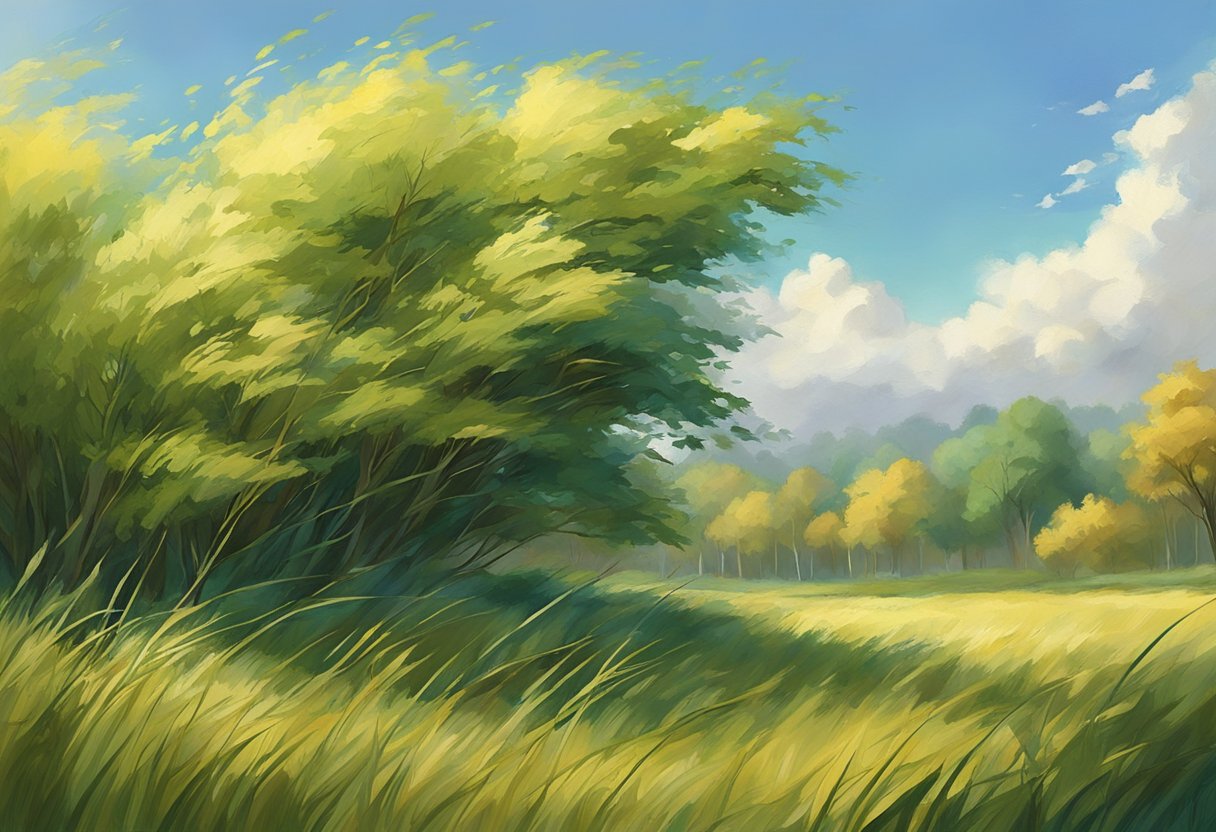
Descriptive language is an essential tool for writers who want to create vivid and engaging descriptions of wind. This section will explore some of the most effective techniques for describing wind, including the use of adjectives and adverbs, similes and metaphors, and master lists for writers.
Using Adjectives and Adverbs
Adjectives and adverbs are two of the most important parts of speech when it comes to describing wind. Adjectives are words that describe nouns, while adverbs describe verbs, adjectives, and other adverbs. When describing wind, it is important to choose adjectives and adverbs that accurately convey the speed, direction, and force of the wind.
For example, writers might use adjectives like “strong,” “gentle,” “fierce,” or “blustery” to describe the wind’s intensity. Adverbs like “swiftly,” “forcefully,” “gently,” or “erratically” can be used to describe the wind’s movement.
Employing Similes and Metaphors
Similes and metaphors are powerful tools for writers who want to create vivid and memorable descriptions of wind. A simile is a comparison between two things using “like” or “as.” A metaphor is a comparison between two things without using “like” or “as.”
For example, a writer might describe the wind as “howling like a pack of wolves” or “whipping through the trees like a tornado.” These similes help readers to imagine the sound and movement of the wind in a more visceral way.
Metaphors can also be used to describe wind more abstractly. For example, a writer might describe the wind as “a restless spirit” or “an invisible force.” These metaphors help to convey the power and unpredictability of the wind.
Master Lists for Writers
Finally, master lists can be a helpful resource for writers who want to create more varied and nuanced descriptions of wind. These lists might include synonyms for common adjectives and adverbs, as well as more specialized vocabulary related to meteorology and weather patterns.
For example, a writer might consult a master list to find alternative words for “strong” or “gusty,” such as “blustery,” “tempestuous,” or “squally.” These lists can help writers to avoid repetitive language and to find more precise and evocative ways of describing wind.
Types of Wind and Their Connotations
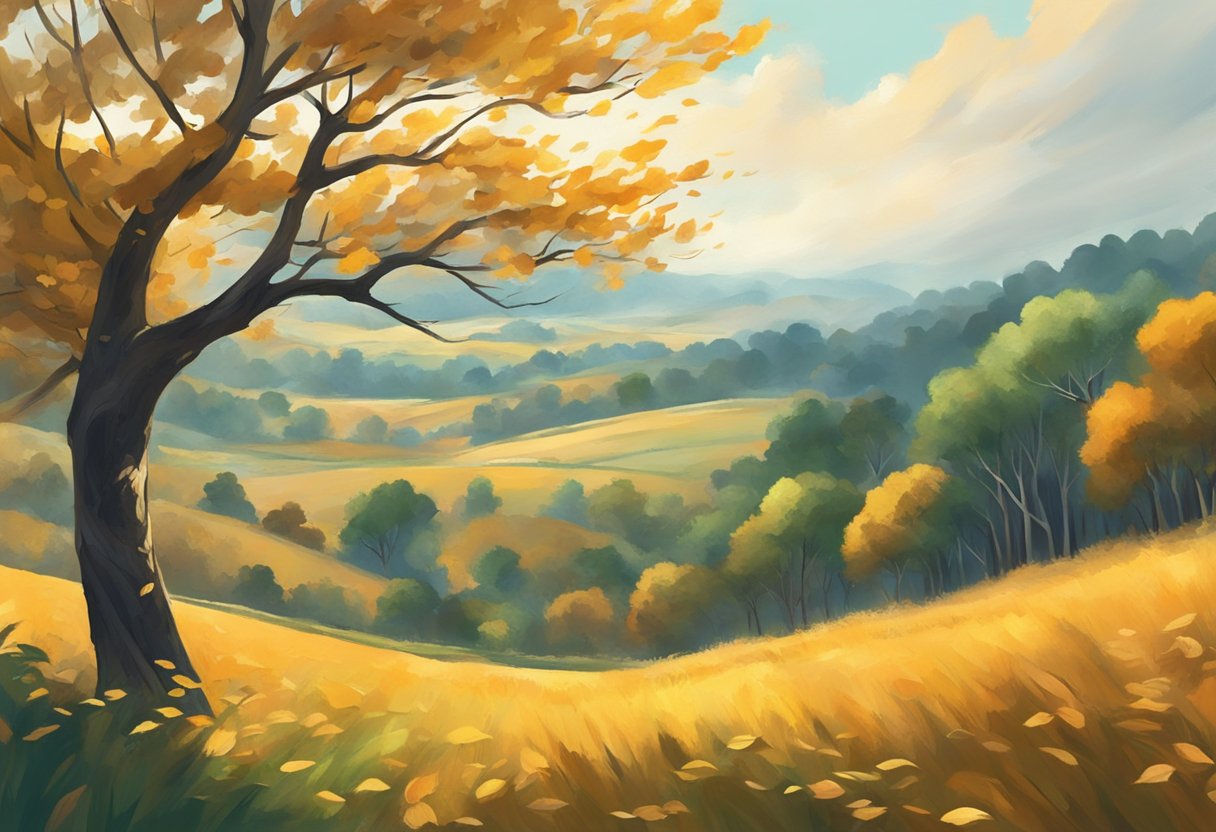
From Breeze to Gale
Wind can range from a gentle breeze to a powerful gale, and each type of wind carries its own connotations. A breeze is a light wind that can be refreshing and pleasant, while a gust is a sudden, strong burst of wind that can be startling. A strong wind, such as a gale, can be destructive, causing damage to buildings and trees.
The force of the wind can also affect its connotation. A gentle breeze can be calming and peaceful, while a strong wind can be chaotic and unsettling. In literature, the wind is often used as a metaphor for change or turbulence, and the strength of the wind can reflect the intensity of the situation.
The Impact of Extreme Weather
Extreme weather conditions, such as hurricanes, blizzards, and tornadoes, can cause significant damage and have a lasting impact on people and communities. These types of wind are often associated with danger, destruction, and chaos.
A hurricane is a powerful tropical storm that can cause flooding and destruction, while a blizzard is a severe snowstorm that can cause travel disruptions and power outages. A tornado is a violent windstorm that can cause significant damage to buildings and homes.
In literature, extreme weather can be used to create tension and suspense, as characters struggle to survive in dangerous conditions. The connotations of extreme weather are often negative, reflecting the destructive power of nature.
Overall, wind can carry a variety of connotations, depending on its strength and the weather conditions in which it occurs. Whether it is a gentle breeze or a powerful hurricane, wind can have a significant impact on the world around us.
Incorporating Sensory Details
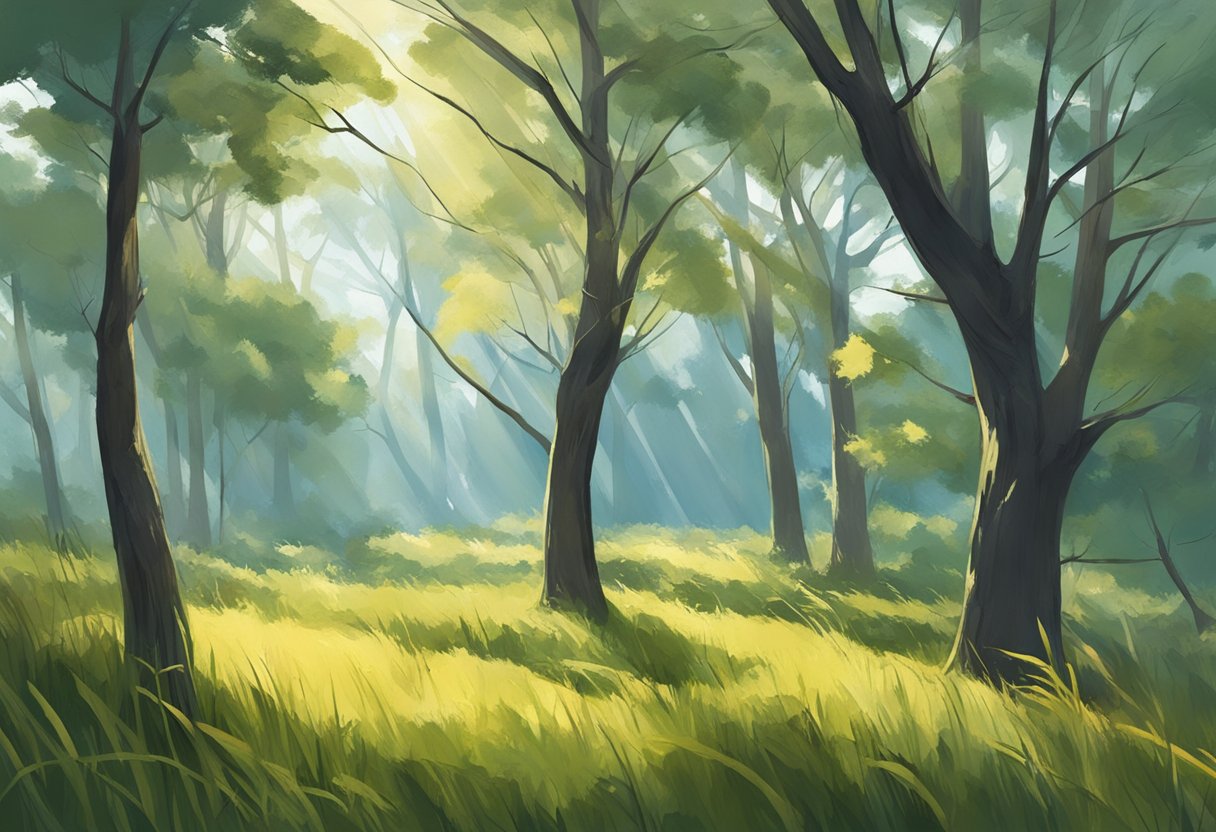
When describing wind, incorporating sensory details can help bring the reader into the scene and make the experience more immersive. The following subsections will cover different sensory details that can be used to describe wind.

The Feel of Wind
Describing the feel of wind can be done in a variety of ways. For example, if the wind is strong, it may feel like a force pushing against the skin. On the other hand, a gentle breeze may feel like a soft caress. The feel of wind can also be described about other objects, such as how it causes hair or leaves to sway.
Visual and Auditory Descriptions
In addition to the feel of wind, visual and auditory descriptions can also be used to convey the experience. For example, the rustle of leaves or grass can be used to describe the sound of wind. The movement of trees or other objects can also be used to visually depict the wind’s strength and direction.
When describing wind, it is important to consider the different senses and how they can be used to create a more vivid picture for the reader. Using sensory details such as the smell of petrichor or the sensation of wind on the skin can help transport the reader to the scene and make the experience more immersive.
Seasonal and Weather Variations
Winter’s cold to autumn’s whisper.
The wind can have a different feel depending on the season. In winter, the wind can be biting and cold, carrying with it the chill of snow and ice. Describing this wind can be done with words such as “frigid,” “icy,” and “blistering.” In contrast, autumn’s wind can be soft and gentle, whispering through the trees and carrying with it the scent of fallen leaves. Words such as “whispering,” “rustling,” and “murmuring” can be used to describe this wind.
Storms and Calm
Stormy weather can bring with it powerful winds that can knock down trees and cause damage. Describing this wind can be done with words such as “howling,” “roaring,” and “blustering.” On the other hand, calm weather can bring with it a gentle breeze that can be described with words such as “caressing,” “soothing,” and “gentle.”
In foggy weather, the wind can feel damp and heavy, carrying with it the moisture of the fog. This wind can be described with words such as “damp,” “heavy,” and “moist.” Sleet and freezing rain can also be carried by the wind, making it feel cold and biting. Words such as “piercing,” “stinging,” and “sharp” can be used to describe this wind.
In warm weather, the wind can feel refreshing and invigorating, carrying with it the scent of blooming buds and the warmth of the sun. Words such as “invigorating,” “refreshing,” and “balmy” can be used to describe this wind.
Overall, there are many ways to describe the wind depending on the season and weather conditions. By choosing the right words, a writer can effectively convey the feeling and atmosphere of the wind to their readers.
Latest posts

Achieving Your Word Count Goals with Daily Sprints: A Guide
Many writers struggle with meeting their word count goals, whether it’s for a school assignment, a blog post, or a novel. It can be frustrating to stare at a blank page or screen and feel like you’re not making progress. However, there is a technique that can help you achieve your word count goals and…

Beat Burnout: Setting Reasonable Writing Expectations
Writing can be a fulfilling and rewarding experience, but it can also be exhausting and draining. Writing burnout is a real phenomenon that can affect anyone, from professional writers to students. When writers push themselves too hard, they can experience stress, lack of motivation, and even physical symptoms like headaches and fatigue. To avoid burnout,…

Dealing with Criticism and Rejection as an Author: Tips and Strategies
As an author, receiving criticism and rejection is an inevitable part of the writing process. It can be difficult to navigate the emotions that come with having your work scrutinized, but it’s important to remember that criticism and rejection are not personal attacks. Instead, they are opportunities for growth and improvement. One way to deal…

31 Ways to Better Describe the Wind in Your Writing
By: Author Hiuyan Lam
Posted on Last updated: October 20, 2023
Categories Vocabulary Boosters

As a writer, you’ll have to find the most unique and effective words to describe every emotion, sight and general experience you are trying to convey to your readers. Sometimes, you’ll even need words to describe wind to refer to certain characteristics such as temperature, force and sound.
In other instances, the words to describe wind can be used in a way to describe how it feels on a character’s skin or how other people react to the wind. We are sure you are good at what you do, but a good writer is always looking for ways to improve his/her craft.
Here are 31 examples of words to describe wind that can better express yourself to your audience:
What is the wind like in your writing?
Before we get to the words to describe wind, let us first establish what the wind is like in your writing. What we mean by that is what is the force of the wind? Wind is always moving air, but it can be gentle, such as a light breeze, or violent, as in a hurricane or tornado. The first thing you should do is establish the force of the wind. The force of the wind is measured in knots on the Beaufort Wind Scale and is further described by the effect it has on the surroundings. The most common terms include:


You May Also Like:
35 Words to Describe a Forest Well in a Novel
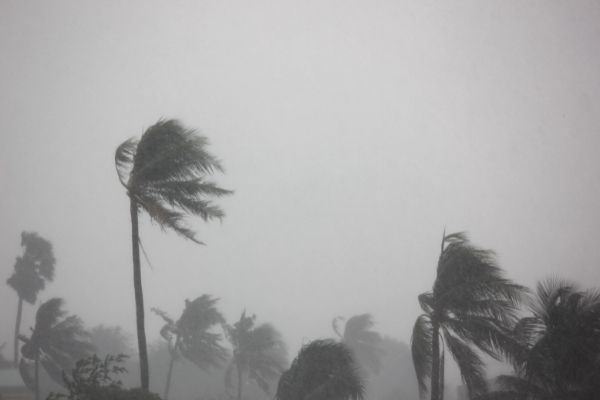
Tornadoes are not included on this scale, but it is understood that they are characterized by violent wind speeds. Tornadoes are instead measured on the Fujita Tornado Scale. This scale begins with an intensity of F0 called a Gale Tornado. A gale tornado measures 35-62 knots and causes minimal damage, inclusive of damage to signboards, shallow-rooted trees, TV antennas, chimneys and windows. At the end of the scale is F6, otherwise called the Inconceivable Tornado . These winds are extremely unlikely as they range between 277-329 knots, and would level houses, remove houses from foundations, overturn and throw automobiles including trains, throw steel and concrete missiles, and in general cause catastrophic damage. This would typically be used in fictional pieces if you want to describe an apocalyptic event. Feel free to browse the rest of the Fujita Tornado Scale for more details. You may have also heard of a wind gust. This describes a sudden, brief increase in wind speed. This can be especially dangerous due to their unpredictable nature and strength.
How to describe wind
After analyzing that list, you should be able to find which scientific word matches what you have in mind. Now, you need some other descriptive words to describe wind to supplement it and really drive home what you’re trying to convey. Let’s start with these 15 words to describe wind:
Words to describe wind by temperature
Temperature describes how hot or cold something is. Here are some descriptive words to describe wind based on temperature:
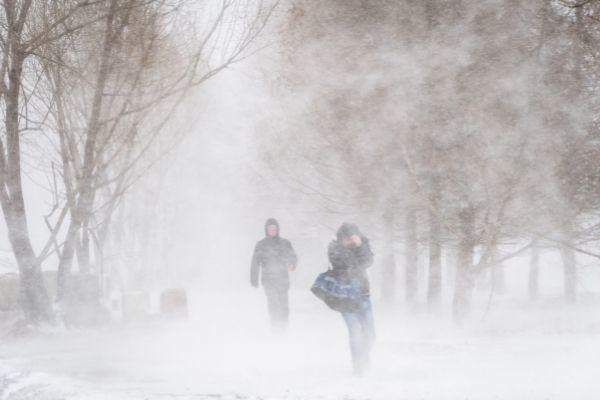
For example: “Eric wiped the sweat from his brow and returned his glasses to his face, wishing he had remembered to pack his balaclava to brave the dry winds in the hot desert.”

Words to describe wind by force
Force describes the intensity or strength of the wind. Here are some words to describe wind based on force:
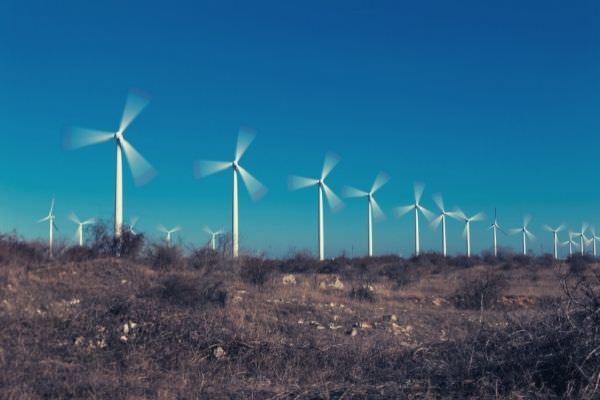
20 Examples of Words to Describe a Laughter in Different Scenarios
Words to describe wind by sound
When there is a strong enough wind, you will hear it. Here are some words to describe wind and what it sounds like to you or the characters:
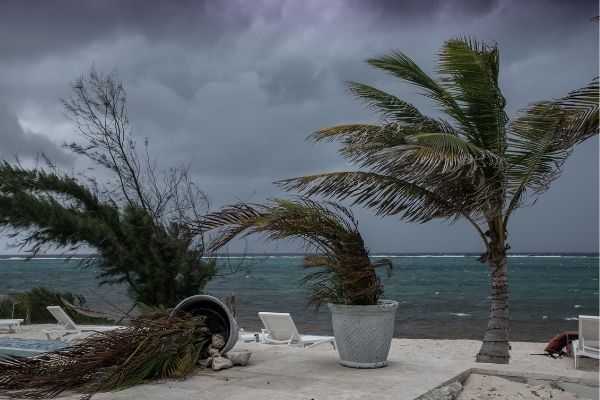
Examples of sensory descriptions to describe the winds
Now, let’s describe the wind from another angle. Let’s use words to describe wind based on our senses, or how people react to it. Here are 16 examples:
By the feeling on your skin
Wind doesn’t always feel the same when it touches your skin. Think about it, does the hot air feel the same as a cool breeze? Not at all. These are some words to describe wind and how it appeals to the sense of touch:
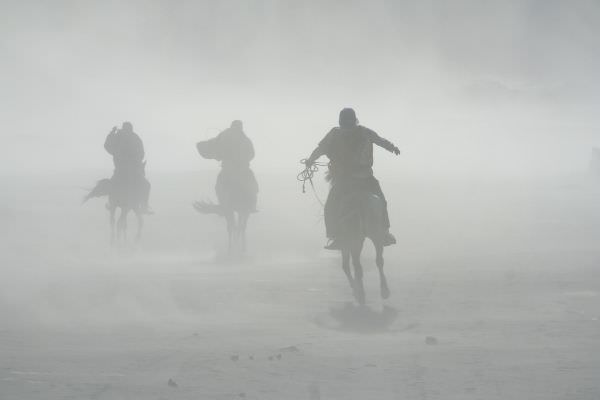
25 of the Best Words to Describe a Bad and Toxic Relationship
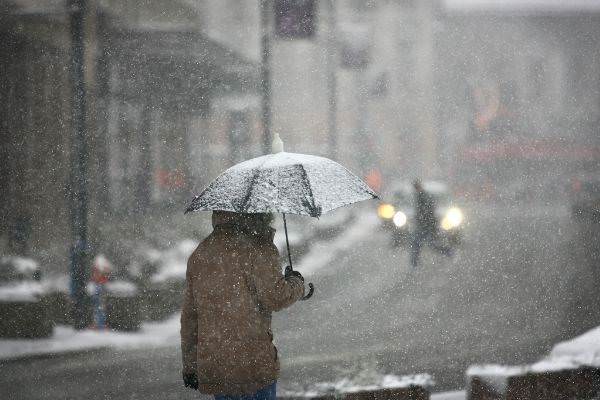
How to describe the wind by how people react to it
When the wind contacts our skin, it can evoke different feelings and reactions. Here are some words to describe wind based on how people react to it/feel:
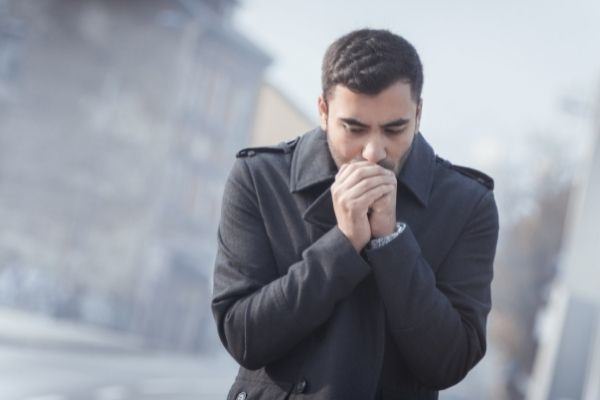
There are many more words to describe wind that you’ve probably never even thought of using before. You just have to be more creative, especially when writing. Which words to describe wind are you going to use first and have you thought of any yourself?

Paragraph on Weather
Students are often asked to write a paragraph on Weather in their schools. And if you’re also looking for the same, we have created 100-word, 200-word, and 250-word paragraphs on the topic.
Let’s take a look…
Paragraph on Weather in 100 Words
Weather is how the sky looks and feels outside. Sometimes it is sunny, and the sun shines bright. On other days, clouds cover the sky, and it may rain or snow. When it’s windy, you can see trees swaying. In winter, it gets cold, and we wear warm clothes. In summer, it’s hot, and we enjoy ice cream to cool down. Weather changes a lot, so we need to be ready for it. It’s important to know the weather so we can plan what to wear and what activities to do each day.
Paragraph on Weather in 200 Words
Weather is how the air feels outside. It can be sunny, rainy, windy, or snowy. When it’s sunny, the sky is bright and warm. Rainy weather brings water falling from the sky. Windy days make things move around a lot. Snowy weather covers everything with fluffy white snow. We wear different clothes depending on the weather. On sunny days, we wear light clothes to stay cool. When it’s cold, we put on warm jackets and hats. Sometimes the weather changes quickly, making it hard to know what to wear. People use umbrellas when it rains to stay dry. Weather can be fun to watch and talk about. It helps us decide what activities to do each day. We can play outside when it’s sunny or build a snowman when it snows. Weather is always changing, so it’s important to pay attention to the sky to know what the day will be like.
Also check:
- 10 Lines on Weather
- Essay on Weather
Paragraph on Weather in 250 Words
Weather is what we feel outside, like if it’s sunny, rainy, windy, or snowy. It changes a lot and can be different in different places. We have seasons like summer, winter, spring, and fall because of how the weather changes throughout the year. Sometimes the weather can be nice and warm, making it perfect for playing outside or going for a picnic. Other times, it might be cold and snowy, so we wear warm clothes and stay cozy indoors. Weather can also be unpredictable, meaning it’s hard to know exactly what it will be like. We use tools like thermometers to measure how hot or cold it is, and weather forecasts help us know what to expect. Different types of weather can affect us in various ways. For example, too much heat can make us feel tired, while too much rain can make it difficult to go outside and play. It’s essential to pay attention to the weather so we can be prepared and stay safe. By understanding the weather, we can make the most of each day, no matter what it brings.
That’s it! I hope the paragraphs have helped you.
Explore other popular paragraph topics:
- Paragraph on Weekend Routine
- Paragraph on What I Enjoy Doing Most
- Paragraph on Wellness Massage
Apart from these, you can look at all the essays by clicking here .
Happy studying!
Leave a Reply Cancel reply
Your email address will not be published. Required fields are marked *
Save my name, email, and website in this browser for the next time I comment.


How to Describe the Wind in Writing (100 Words + Examples)
It can be a bit tricky to find the right words or phrases to make your readers see and feel the wind.
Here is how to describe the wind in writing:
Describe the wind in writing by using sensory language to evoke its force, sound, temperature, effect, direction, time of day, and personified traits. Each description should enhance the narrative, helping to set the scene, build atmosphere, and engage the reader.
In this guide, we’ll discuss all the different ways to describe wind based on its force, sound, speed, and more.
Describing Wind by Its Force

Table of Contents
The force of the wind can dramatically change the perception of a scene.
The contrast between a gentle breeze and a violent gale is not just a measure of intensity.
But can also signify changing moods, symbolize emotional shifts, or foreshadow significant events.
Here is how to do it:
- Gentle : A gentle wind softly touches, a delicate interaction with the environment. Example: “The gentle wind caressed the petals of the blooming flowers, their fragrance subtly wafting in the air.”
- Light : A light breeze is almost playful, just strong enough to stir the leaves. Example: “A light wind tugged at her hair as she sat by the river, the tranquil scene filling her with peace.”
- Calm : A calm wind denotes tranquility and serenity, ideal for peaceful settings. Example: “The calm wind moved lazily through the tall grass, making it sway like waves in a calm sea.”
- Whispering : A whispering wind is quiet, giving a sense of intimacy and closeness. Example: “The whispering wind carried the melody of the distant lullaby, lulling the town to sleep.”
- Soothing : A soothing wind provides relief or comfort. Example: “The soothing wind was a balm against the harsh summer heat, its gentle caress reviving his spirits.”
- Blustery : A blustery wind is strong and cold, often associated with the autumn and winter months. Example: “The blustery wind cut through his jacket, making him shiver as he trod the leaf-strewn path.”
- Howling : A howling wind is fierce, invoking images of storms or tempests. Example: “The howling wind made the old house creak ominously, its eerie tune setting the mood for the night.”
- Fierce : A fierce wind indicates a wild and uncontrolled force. Example: “The fierce wind shook the window panes, a testament to the storm’s power.”
- Wild : Wild wind suggests a sense of chaos and lack of control. Example: “The wild wind tossed the ship like a toy, waves crashing over the deck.”
- Gusty : Gusty winds are strong and sudden, capable of causing brief moments of disarray. Example: “The gusty wind snatched the papers from his hands, scattering them in every direction.”
Describing Wind by Its Sound
The sound of the wind is often used to set the atmosphere of a scene.
From the silent rustling of leaves to the ominous howling in a storm, the sonic quality of wind can bring your writing to life.
- Soft : A soft wind might be barely audible, adding a sense of tranquility. Example: “The soft rustle of the wind through the trees was a soothing backdrop to their quiet conversation.”
- Hushed : A hushed wind is a secret whisper, barely noticeable. Example: “A hushed breeze stirred the silent forest, the only sign of life in the deep wilderness.”
- Silent : A silent wind might not make any sound, but its effects can be seen or felt. Example: “The silent wind danced with the dunes, shifting the desert landscape as if alive.”
- Quiet : A quiet wind does not overpower other sounds, acting as a subtle background note. Example: “The quiet wind murmured through the leaves, a soft accompaniment to the chorus of singing birds.”
- Noisy : A noisy wind is boisterous, drawing attention to its presence. Example: “The noisy wind rustled the newspapers, alerting the alley cat of someone’s approach.”
- Roaring : A roaring wind has a deep, loud sound, often associated with storms or extreme weather. Example: “The roaring wind was deafening, drowning out all other sounds.”
- Screaming : A screaming wind gives the impression of high intensity or danger. Example: “The wind screamed around them, a chilling prelude to the approaching hurricane.”
- Howling : A howling wind is loud and sorrowful, invoking a sense of loneliness or fear. Example: “The howling wind seemed to voice the loneliness of the old mansion, its chilling song echoing in the empty rooms.”
- Whistling : A whistling wind creates high-pitched sounds as it passes through narrow spaces. Example: “The wind whistled through the bare branches, a lonely melody in the frigid winter air.”
- Moaning : A moaning wind can suggest discomfort or eeriness. Example: “The wind moaned through the ruined tower, its ghostly sighs stirring tales of lost battles and ancient sorrows.”
Describing Wind by Its Speed
The speed of the wind can influence the rhythm and pacing of your writing.
Slow winds might suggest a leisurely pace, while fast winds can bring energy and excitement.
- Slow : A slow wind suggests a relaxed or languid mood. Example: “The slow wind moved lazily across the field, the daisies bending and swaying in a slow dance.”
- Lazy : A lazy wind has a lackadaisical quality, perfect for a calm, sunny afternoon. Example: “A lazy wind drifted through the orchard, the scent of ripe apples carried in its wake.”
- Languid : A languid wind is slow and relaxed, hinting at tranquility and leisure. Example: “The languid breeze that wafted from the sea brought a sense of calm and serenity.”
- Meandering : A meandering wind takes its time, as though it’s enjoying the journey rather than rushing towards a destination. Example: “The meandering wind played amidst the autumn leaves, carrying them on a leisurely dance.”
- Drifting : A drifting wind is unhurried and aimless, adding a dreamlike quality to the scene. Example: “The drifting wind carried the scent of lilacs, its sweet perfume invoking memories of past summers.”
- Fast : A fast wind is full of energy, ideal for scenes of action or urgency. Example: “The fast wind whipped her hair around her face as she raced down the hill.”
- Quick : A quick wind might signal an abrupt change or a breathless moment. Example: “The quick wind brought the first hint of the storm, the air suddenly heavy with tension.”
- Swift : A swift wind brings movement and flow to the scene, emphasizing speed and motion. Example: “The swift wind carried the fallen petals, creating a blizzard of cherry blossoms.”
- Rushing : A rushing wind suggests urgency or turmoil. Example: “The rushing wind tore through the narrow streets, a harbinger of the tempest to come.”
- Speeding : A speeding wind signifies rapid movement and can be used to convey a sense of excitement or danger. Example: “The speeding wind roared in his ears as he plummeted towards the ground, his parachute trailing behind him.”
Describing Wind by Its Temperature
The temperature of the wind can greatly influence the overall feeling of a scene.
Whether a warm summer breeze or a frigid winter gust, the wind’s temperature can evoke a range of emotions and sensations in the reader.
- Warm : A warm wind suggests comfort and the promise of balmy weather. Example: “The warm wind, heavy with the scent of blooming jasmine, hinted at the approaching summer.”
- Hot : A hot wind can be oppressive, often associated with desert or drought conditions. Example: “The hot wind carried the sting of the sand, searing any exposed skin.”
- Cool : A cool wind is often refreshing, a welcome relief from the heat. Example: “The cool wind that rustled the palm leaves brought momentary relief from the tropical heat.”
- Cold : A cold wind might suggest discomfort or harsh weather conditions. Example: “The cold wind gnawed at their cheeks, turning them a rosy pink.”
- Chilling : A chilling wind often connotes something ominous or foreboding. Example: “The chilling wind blew through the graveyard, making the mourners shiver uncontrollably.”
- Icy : An icy wind is not only cold but also piercing, cutting through layers of clothing. Example: “The icy wind cut through her coat like a knife, making her shudder with cold.”
- Frigid : A frigid wind can suggest extreme cold, often associated with winter or high-altitude settings. Example: “The frigid wind howled across the snow-covered mountains, stinging any exposed skin.”
- Scorching : A scorching wind is intensely hot, like being in an oven or near a fire. Example: “The scorching wind was like a wall of heat, making the mere act of breathing a challenge.”
- Refreshing : A refreshing wind is cool and invigorating, often associated with spring or morning breezes. Example: “The refreshing wind stirred the wildflowers, carrying their sweet scent across the meadow.”
- Biting : A biting wind is harsh and painful, carrying an insinuation of discomfort or hostility. Example: “The biting wind whipped around them, making every step a battle against the elements.”
Describing Wind by Its Effects
Another way to describe the wind is by the impact it has on the surrounding environment.
This can provide a vivid, indirect way of conveying the strength or character of the wind.
- Rustling : A rustling wind gently stirs leaves and grass. Example: “The rustling wind stirred up the autumn leaves, creating a colorful whirlwind.”
- Whipping : A whipping wind moves with force, capable of causing disarray. Example: “The whipping wind tore at their clothes, making it hard to move forward.”
- Caressing : A caressing wind moves gently, like a lover’s touch. Example: “The caressing wind played with her hair, sending shivers down her spine.”
- Tugging : A tugging wind pulls at things, providing a sense of its strength. Example: “The tugging wind pulled at his hat, threatening to send it flying.”
- Stirring : A stirring wind causes slight movement, especially in water or loose particles like sand or dust. Example: “The stirring wind created tiny ripples across the pond, disturbing the otherwise mirror-like surface.”
- Sweeping : A sweeping wind suggests broad, fast movement over a large area. Example: “The sweeping wind cleared the fog, revealing the breathtaking vista of the valley below.”
- Roaring : A roaring wind gives an impression of intensity and might. Example: “The roaring wind stripped the trees of their autumn leaves, leaving the branches bare and exposed.”
- Dancing : A dancing wind moves unpredictably, swirling and changing direction. Example: “The dancing wind swirled the snowflakes into intricate patterns, as if orchestrating a ballet of the elements.”
- Carrying : A carrying wind can transport scents, sounds, or smaller objects over distances. Example: “The carrying wind brought the distant sound of church bells, drifting on the air like a sacred melody.”
- Buffeting : A buffeting wind strikes repeatedly and forcefully, causing everything in its path to shake or rattle. Example: “The buffeting wind rattled the old window frames, their constant clattering a testament to the storm’s fury.”
Describing Wind by Its Direction
The direction of the wind can have significant implications for your narrative, from determining the movement of clouds to hinting at changes in weather or seasons.
Here is how to describe the wind by its direction:
- North : A north wind, often cold, can signify the arrival of winter or a cooling trend. Example: “The north wind carried the scent of snow, a chilling harbinger of the approaching winter.”
- South : A south wind is typically warm, often suggesting the onset of spring or summer. Example: “The south wind, laden with the heady fragrance of blooming roses, heralded the arrival of a sultry summer.”
- East : An east wind can be seen as bringing change or new beginnings. Example: “The east wind brought the first light of dawn, casting long shadows on the silent town.”
- West : A west wind often carries the connotation of ending or closure. Example: “The west wind carried the last notes of the song, echoing the sun’s farewell as it dipped below the horizon.”
- Upland : An upland wind moves uphill, suggesting effort or challenge. Example: “The upland wind whispered encouraging words in her ear as she climbed the steep hill.”
- Downland : A downland wind moves downhill, hinting at ease or relaxation. Example: “The downland wind guided the fallen leaves on their journey to the valley.”
- Seaward : A seaward wind moves towards the sea, often evoking a sense of longing or adventure. Example: “The seaward wind filled their sails, drawing them towards the vast, unexplored ocean.”
- Landward : A landward wind moves towards land, typically associated with feelings of safety or return. Example: “The landward wind carried the familiar scent of pine and woodsmoke, a promise of home.”
- Incoming : An incoming wind moves towards the observer, indicating the approach of something. Example: “The incoming wind carried the distant rumble of thunder, a stark warning of the storm’s approach.”
- Outgoing : An outgoing wind moves away from the observer, often signaling departure or relief. Example: “The outgoing wind took the last traces of the forest fire, the air finally clear and breathable.”
Describing Wind by Its Time of Day
The time of day can also influence how the wind is perceived, adding an additional layer of nuance to your descriptions.
- Morning : A morning wind suggests freshness and the beginning of a new day. Example: “The morning wind, cool and crisp, breathed life into the sleepy town.”
- Noon : A noon wind often conveys the intensity of the midday sun. Example: “The noon wind, hot and dry, made the mirages dance on the distant horizon.”
- Afternoon : An afternoon wind can signal a gradual easing of the day’s heat. Example: “The afternoon wind brought welcome relief, stirring the lethargic summer air.”
- Evening : An evening wind often indicates the transition from day to night. Example: “The evening wind carried the twilight song of the birds, an enchanting serenade as day gave way to night.”
- Night : A night wind is typically associated with mystery, calm, or the unknown. Example: “The night wind whispered tales of forgotten times, its hushed voice blending with the rustle of the ancient trees.”
- Dawn : A dawn wind implies new beginnings or hope. Example: “The dawn wind stirred the sea into a shimmering canvas, painting the first light of day in vibrant hues of orange and gold.”
- Dusk : A dusk wind carries the end of the day and the onset of the evening. Example: “The dusk wind rustled the falling leaves, echoing the sun’s farewell as it dipped below the horizon.”
- Midnight : A midnight wind can evoke the depth of the night and the mysteries it holds. Example: “The midnight wind carried the eerie howls from the distance, its chilling message clear in the silent night.”
- Daybreak : A daybreak wind suggests renewal or a fresh start. Example: “The daybreak wind carried the scent of dew-kissed grass, a subtle hint of the world awakening to a new day.”
- Twilight : A twilight wind signifies transition or change, often bringing a sense of calm. Example: “The twilight wind stirred the lavender fields, their soothing scent bringing a serene end to the day.”
Describing Wind by Its Smell
Scents carried by the wind can help set the scene and evoke strong emotions and memories in your readers.
Here are a few ways you can describe wind by its smell:
- Salt-tinged : A wind that carries the smell of the sea. Example: “A salt-tinged wind swept across the deck, instantly transporting him back to his childhood summers by the ocean.”
- Pine-scented : A wind carrying the aroma of pine forests. Example: “The pine-scented wind was a refreshing balm, cleaning the city smog from her lungs.”
- Smoky : A wind that carries the smell of smoke, indicating a fire. Example: “The smoky wind stung their eyes and throats, a cruel herald of the approaching wildfire.”
- Floral : A wind filled with the scent of flowers. Example: “A floral wind drifted through the open window, the intoxicating perfume of the garden mingling with the crisp linen sheets.”
- Dusty : A wind that carries the smell of dust or dry earth. Example: “The dusty wind was a tangible reminder of the long, parched summer.”
- Rain-soaked : A wind carrying the fresh smell of rain or an approaching storm. Example: “The rain-soaked wind promised a respite from the relentless heat.”
- Herb-laden : A wind filled with the smell of herbs, indicating a nearby garden or meadow. Example: “The herb-laden wind carried notes of lavender and rosemary, a comforting reminder of home.”
- Citrusy : A wind carrying the zesty aroma of citrus fruits. Example: “A citrusy wind drifted from the orange groves, filling the afternoon with a tangy sweetness.”
- Decaying : A wind that carries the smell of decay, indicating rot or death. Example: “The decaying wind held the grim scent of the battlefield, a chilling testament to the day’s losses.”
- Spicy : A wind filled with the scent of spices, indicating a nearby marketplace or kitchen. Example: “The spicy wind was thick with the promise of delicious meals, making her stomach growl in anticipation.”
Describing Wind by Its Feeling
Describing the wind by its physical sensation on a character’s skin can help immerse the reader in the scene.
- Stinging : A wind that is harsh and biting. Example: “The stinging wind battered his face, each gust like a slap of cold, wet canvas.”
- Tickling : A light wind that playfully brushes against the skin. Example: “The tickling wind teased her bare arms, leaving goosebumps in its wake.”
- Caressing : A gentle wind that softly touches the skin. Example: “The caressing wind was a tender lover, its soft touch bringing comfort to her weary body.”
- Slapping : A strong, abrupt wind. Example: “The slapping wind caught her off guard, its sudden force nearly knocking her off her feet.”
- Grazing : A gentle wind barely noticeable on the skin. Example: “The grazing wind was a soft sigh against her cheek, a barely-there touch that hinted at the storm’s retreat.”
- Biting : A cold, harsh wind that feels as though it’s biting into the skin. Example: “The biting wind gnawed at his fingertips, the relentless cold seeping through his gloves.”
- Scratching : A wind carrying sand or tiny debris that feels abrasive on the skin. Example: “The scratching wind was a desert beast, its sandy claws scraping against his exposed skin.”
- Soothing : A wind that brings relief or comfort. Example: “The soothing wind was a welcome respite from the stifling heat, its gentle caress cooling her sunburnt skin.”
- Clammy : A wind that is damp and cold. Example: “The clammy wind clung to her clothes, the damp chill seeping into her bones.”
- Prickling : A wind that makes the skin tingle, often due to cold or static. Example: “The prickling wind was a ghost’s touch, its chilling caress raising goosebumps on her skin.”
Here is a video on how to describe a windy day:
How Do You Personify Wind?
Personification is a powerful literary device that gives human characteristics to non-human entities.
When it comes to the wind, personification can be an excellent tool to create vivid imagery, build atmosphere, and engage readers on a deeper level.
Consider these techniques to personify the wind:
- Whispering : Giving the wind the ability to whisper can make it seem secretive or intimate. Example: “The wind whispered through the treetops, carrying secrets from one part of the forest to another.”
- Laughing : A laughing wind can express joy, freedom, or mischief. Example: “The wind laughed in the open fields, playfully rustling the wildflowers as it passed.”
- Singing : When the wind sings, it creates a sense of harmony or melody. Example: “The wind sang a lullaby, its soothing hum gently lulling the world to sleep.”
- Mourning : A mourning wind carries an impression of sadness or loss. Example: “The wind mourned through the empty streets, a sorrowful echo of the town’s former life.”
- Dancing : A dancing wind implies movement, celebration, or unpredictability. Example: “The wind danced through the autumn leaves, twirling them in a whirl of gold and red.”
- Roaring : A roaring wind can depict anger, might, or wildness. Example: “The wind roared across the desolate plains, venting its fury on the barren landscape.”
- Caressing : If the wind is caressing something, it gives a sense of gentleness or affection. Example: “The wind caressed the waves, leaving a trail of shimmering ripples in its wake.”
- Teasing : A teasing wind suggests playfulness and lightness. Example: “The wind teased her hair, tossing it this way and that in a playful game.”
- Sighing : A sighing wind can convey disappointment, relief, or resignation. Example: “The wind sighed through the abandoned corridors, echoing the despair left behind.”
- Chasing : A chasing wind implies speed, pursuit, or play. Example: “The wind chased the fallen leaves, their rustling flight a merry chase across the park.”
Final Thoughts: How to Describe the Wind in Writing
When you describe wind in your story, try to link your description to the plot, theme, characters, and specific scene.
Everything should tie into the same knotted storyline.
Related posts:
- How To Describe a House in Writing (21 Tips for Beginners)
- 400+ Words to Describe a Flower Garden: Best Writers Guide
- How to Describe a Sunset in Writing: 100 Best Words & Phrases
- How to Describe a Ghost in Writing (Tips, Words, Examples)
You are using an outdated browser. Please upgrade your browser or activate Google Chrome Frame to improve your experience.
An Easy Guide to Talking About Weather in English: 121 Key Words and Phrases You Need to Know
Whether you’re standing in the grocery checkout line or meeting new people at a party, the weather is a popular conversation starter.
Many of us keep the weather forecast on our phones, and it helps us decide what we’re going to do for the day.
In this post, you’ll learn all the terms you need to talk about weather in English, like describing sunny days, stormy days and all those in between —as well as why the weather is considered such a hot topic.
How to Talk About Weather in English
1. how’s the weather / what’s it like out there, 2. what’s the temperature like (out there), 3. what’s the weather forecast, 4. what a beautiful day, 5. it’s warm and sunny outside., 6. we couldn’t ask for better weather., 7. this is the best weather we’ve had all season, 8. awful weather, isn’t it, 9. it’s boiling hot, 10. it’s freezing outside, 11. i can’t believe this weather, 12. it’s raining cats and dogs, 13. it looks like rain., 14. a storm seems to be coming this way., 15. the weather will be warming up soon., 16. it’s expected to be hotter than last year., the difference between weather vs. climate vs. temperature, more useful weather words in english, words to describe the weather in english, vocabulary for extreme weather conditions, weather clothes and accessories in english, weather idioms in english, and one more thing....
Download: This blog post is available as a convenient and portable PDF that you can take anywhere. Click here to get a copy. (Download)
Whether you’re at the coffee machine or waiting your turn at the post office, you might get into a casual conversation with the person next to you about what’s happening outside.
Here are some phrases to talk about the weather in English.
Both of these are good questions to ask if you haven’t gone outside in a while, and you’re wondering if things have changed.
Or maybe you’re still debating about whether or not you want to venture (go) outdoors, so you might ask this to someone who comes inside.
This question is asking about degrees in Fahrenheit or Celsius . However, people are typically looking for an approximate temperature:
It’s around 40°.
Of course, an answer like the following is still acceptable:
It’s really (hot/cold/warm/cool).
If you’re planning a trip or event, you might want to know the weather ahead of time. Forecast simply refers to what kind of weather is expected in the coming days or weeks.
Use other adjectives like nice or gorgeous to make your descriptions more interesting.
This is a simple sentence using two or more descriptive adjectives.
It’s warm and windy outside.
Blue skies is a phrase meaning a sign of good weather:
There’s nothing but blue skies outside.
Here the use of the comparative adjective better suggests that the weather is so good that it couldn’t get any better. You could use other comparative adjectives like nicer or more beautiful .
We couldn’t ask for nicer weather this week!
The superlative adjective best is used to show that this weather is simply the best and nothing else can be better. You can also use worse with this sentence structure.
Here’s another example:
This is the most beautiful weather we’ve had all week!
This is the worst weather we’ve had all spring!
Using the question form can be quite refreshing, especially when you expect the person to agree with you. You could use similar adjectives like nasty or terrible instead.
Nasty weather today, isn’t it?
The word boiling is used here as an adjective, not as a verb, to create an image of how hot it is. You could also use adverbs like extremely or really .
In this simple sentence, you may use any verb in its -ing form to describe the weather, such as pouring (raining very heavily) or sizzling (very hot).
Here’s a simple way to express your surprise. Feel free to use any other suitable noun such as storm or wind .
This is a popular idiom (expression) for saying that it’s raining heavily. Have fun with it.
Here you’re saying it looks like it might rain in the near future. It could be that you can see dark clouds or hear thunder. You could use other nouns like snow or a storm .
The phrase seems to be suggests that a storm is likely to be coming. You could also say:
Heavy rain seems to be heading this way.
Warming up means the temperatures will be rising and it’s getting warmer. The opposite of that would be:
The weather will be cooling down soon.
The phrase expected to be suggests that you think it’ll happen.
Use a comparative adjective here to compare the weather now with another time in the past. You could use other comparative adjectives like colder or less windy .
In English, the words “weather,” “climate” and “temperature” usually aren’t interchangeable. This means they have slightly different meanings.
Weather is used to describe what’s going on outside. For example, the weather can be stormy, sunny, cloudy or rainy.
Climate refers to the weather tendencies of a place. For example, the climate of Texas—a state in the United States—can be described as scorching hot summers and mild winters.
Finally, the temperature is how hot or cold it is outside. In most countries, the temperature is expressed in degrees Celsius. But in the United States, you’ll hear the degrees in Fahrenheit.
Examples of temperatures are 85 degrees, 90 degrees and 32 degrees.
If you’re looking for more vocabulary to help you talk about the weather in English, here’s everything you need:
So there you have it—a great list of weather words and phrases to get you talking about weather like a native speaker .
I expect you’ll warm up to (get used to) these sentence structures pretty quickly!
FluentU takes authentic videos—like music videos, movie trailers, news and inspiring talks—and turns them into personalized language learning lessons.
You can try FluentU for free for 2 weeks. Check out the website or download the iOS app or Android app.
P.S. Click here to take advantage of our current sale! (Expires at the end of this month.)

Try FluentU for FREE!
Finally, remember to practice the words, phrases and questions in this post so you can feel comfortable using them in conversations.
If you like learning English through movies and online media, you should also check out FluentU. FluentU lets you learn English from popular talk shows, catchy music videos and funny commercials , as you can see here:

If you want to watch it, the FluentU app has probably got it.
The FluentU app and website makes it really easy to watch English videos. There are captions that are interactive. That means you can tap on any word to see an image, definition, and useful examples.

FluentU lets you learn engaging content with world famous celebrities.
For example, when you tap on the word "searching," you see this:

FluentU lets you tap to look up any word.
Learn all the vocabulary in any video with quizzes. Swipe left or right to see more examples for the word you’re learning.

FluentU helps you learn fast with useful questions and multiple examples. Learn more.
The best part? FluentU remembers the vocabulary that you’re learning. It gives you extra practice with difficult words—and reminds you when it’s time to review what you’ve learned. You have a truly personalized experience.
Start using the FluentU website on your computer or tablet or, better yet, download the FluentU app from the iTunes or Google Play store. Click here to take advantage of our current sale! (Expires at the end of this month.)
Enter your e-mail address to get your free PDF!
We hate SPAM and promise to keep your email address safe


33 Writing Prompts about Weather
Whether or not you enjoy small talk, you have to admit that the weather is important and affects our everyday lives.
We experience many types of weather on Earth, from hot and sunny days to snow-covered nights, and everything else in between.
Rain or shine, these writing prompts aim to help get your brain thinking, so you can turn that thinking into writing!
How to use these prompts:
Using these prompts is simple! Pick one of the prompts from the list and start crafting an answer.
You can go in numerical order down the list or pick a prompt at random.
Remember, don’t judge yourself during this process, just write! Sometimes all it takes is a little inspiration to get us writing and thinking.
Neither snow nor rain nor heat will keep you from enjoying these writing prompts all about the weather! 😉
The 33 Weather Prompts:
- What is your favorite kind of weather? (Rainy, sunny, cloudy, etc.)
- Write about your perfect sunny day. What activities would you do, and where would you go?
- Write about your perfect rainy day in and what you would do.
- Write about your ideal snow day. What would you do, and where would you go?
- What is your least favorite kind of weather? Why?
- Why do you think the weather changes?
- Where do you think rain comes from? How can we know?
- Where do you think snow comes from? What makes it different from rain?
- What do you think the phrase “under the weather” means?
- How does the weather change what activities we can do outside?
- What do you think the phrase “it’s raining cats and dogs” means?
- If the rain was a person, what would they be like?
- If the snow was a person, what would they be like?
- If the wind was a person, what do you think they would be like?
- Why does weather change with the seasons?
- Why do you think the weather is different around the world?
- Do you think other planets have weather? Why or why not?
- If you had to live in the same kind of weather for a year, what would you pick and why?
- How are meteorologists able to predict and forecast the weather?
- Write about a day when you experience all types of weather in 24 hours.
- Try to explain what weather is to someone from another planet who has never seen the rain or felt the wind before.
- The word weather sounds like the word whether, but how are they different?
- Write about a day when it rains the entire day without stopping.
- What do you think the phrase “when it rains, it pours” means?
- Imagine you live in a place that is sunny all year long. Would you get tired of it or enjoy it? Why?
- Imagine you live in a place where it snows every day of the year and write about it.
- Invent a new kind of weather and write about a week of your life with that weather.
- Do you think wind is a type of weather? If not, what is it?
- Imagine that it rains for a month straight. How would life be different?
- What would life be like without any weather at all?
- Pretend that you can control the weather. What would you do and why?
- When someone says they have “stolen your thunder,” what does that mean?
- Would you ever want to be a meteorologist and try to predict the weather? Why or why not?
Left wanting more?
We love providing free writing and reading resources on our website.
Check out our other writing prompts and ideas for students of any age. You might like to try writing about the rain , or the sun , or the ocean for instance!
If you have any suggestions or recommendations for us, please break the ice and get in touch with us, we’d love to hear from you! Thanks and see you again soon 🙂
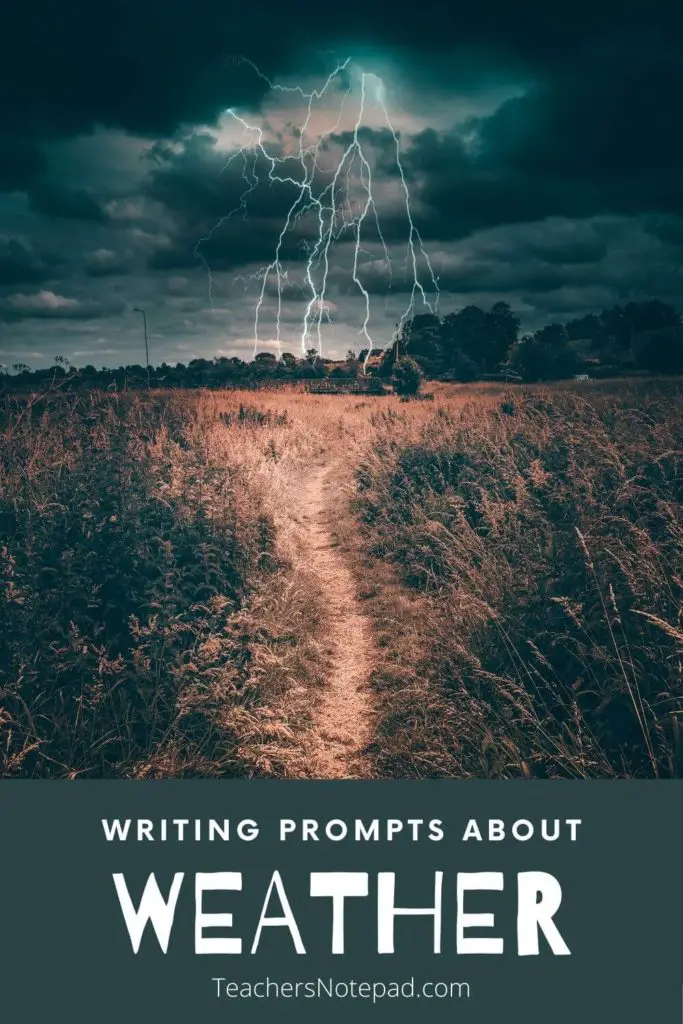
- EssayBasics.com
- Pay For Essay
- Write My Essay
- Homework Writing Help
- Essay Editing Service
- Thesis Writing Help
- Write My College Essay
- Do My Essay
- Term Paper Writing Service
- Coursework Writing Service
- Write My Research Paper
- Assignment Writing Help
- Essay Writing Help
- Call Now! (USA) Login Order now
- EssayBasics.com Call Now! (USA) Order now
- Writing Guides
Windy Day (Essay Sample)
Wind comes with varied speed in an area and depending on different factors. For instance, the wind is likely to be at high speed in a bare land without trees. Some regions also experience high speeds of wind compared to others. The Wind blows hard as trees bend over. Some trees which are weak and unable to sustain the speed of wind break off their branches. People walking around get the effects of wind too; hats are blown off from heads, papers are blown to the sky, and sometimes it becomes hard to walk. Everyone should be aware that strong winds are dangerous to lives and property. There are activities people can take part in on a windy day while avoiding others.
A windy day can be good to get involved in fun activities with kids such as watching the swaying of tree branches, movement of clouds, running towards and away from the direction of wind to feel the different effects, blowing bubbles, watching the surfaces of water bodies to see the effects of wind and also listening to sound of blowing tree leaves. All these activities can be a source of fun to kids and also help parents play with their children. However, there are other activities that can be dangerous to carry out on a windy day.
A windy day is not the favorable one to start a fire in open space or areas near forests, especially during summer seasons. Most of the big forest fires around the world happen when weather temperatures are high and very windy. The wind facilitates fast spreading of fire to uncontrollable states. One has to observe the state of wind before starting an open fire at least to avoid dealing with consequences.
It is dangerous to be high above the ground surface such as inspecting the leaking roof on a windy day. The winds can be very strong and blow away the roof while one still in the process of checking the leakages. This can either result in severe injuries or sometimes death depending on the strength of the wind. It is therefore advisable to follow-up on weather updates and ensure it will be calm before undertaking some activities that are above the ground surface.
The many children games can be fun on a windy day as discussed above. However, it is necessary to be careful with some games such as flying kites. The children are likely to be at risk if they fly the kites while the winds get stronger. They will endanger their lives and parents are likely to find themselves in tough situations of violating airspace rules. Being updated on weather forecast is necessary to avoid such ugly instances.
Playing golf on a windy day is likely to be a bad idea. The golf game will not likely proceed as usual because the wind has the effect of preventing smooth movement of the ball. Injuries are also likely to be high resulting from the uncomfortable playing of the game. It is wise enough to check out on a calm day for a perfect golf game.
In addition, it is dangerous to have a walk or leisure on the beach on a windy day. Winds are likely to blow the sand which can cover the whole body or sometimes result in rising levels of water that sweeps the whole beach. No one wishes to be found in such instances as a result of natural phenomenon.
A windy day can be a good opportunity to have fun and especially with young children but again taking caution is necessary for safety purposes. Following up on reliable weather forecasts is necessary when planning for the activities of the day.


101 Words To Describe Weather
Writers know that using the weather in their descriptions is a great way to make stories more relatable. Use this comprehensive list of words that describe weather when you write.
Writers Write is a resource for writers and we have written about words that describe taste , smell , sound , and touch in previous posts. (We even have one for words that describe colours .) In this post, I have included words that describe weather.
Weather is a wonderful tool for writers. We can use it to foreshadow , create a mood , complicate a plot , show a character , and increase or decrease the pace of a story. We can even use it as a motif .
A setting without the weather is like a character without a wardrobe.
Remember that we need to describe weather through our characters’ interactions with their environments. We should not describe it like a weather report. You could show how cold it is by the clothes they choose to wear or mention the weather in dialogue.
Whatever you do, don’t leave it out. There are unintended consequences to a lack of setting , including a static character, a lack of atmosphere, an inability for the reader to relate to the place and time in the story, and a lack of details.
What Is Weather?
According to Oxford it is ‘the state of the atmosphere at a particular place and time as regards heat, cloudiness, dryness, sunshine, wind, rain, etc.’
Words To Describe Weather
General words describing weather.
- climate – the type of weather that a country or region has
- climate change – changes in the earth’s weather, including changes in temperature, wind patterns and rainfall, especially the increase in the temperature of the earth’s atmosphere that is caused by the increase of particular gases, especially carbon dioxide
- meteorology – the scientific study of weather
- seasonal – suitable or typical of the time of year it is now
- spell – a period when there is a particular type of weather
- weather forecast – a report on likely weather conditions for a period of time in the future
- zone – one of the large areas that the world is divided into according to its temperature
Words Describing Warm Weather
- balmy – warm and pleasant
- blistering – extremely hot in a way that is uncomfortable
- dog days – the hottest days of the year
- heatwave – a continuous period of very hot weather, especially when this is unusual
- Indian summer – a period of warm weather in autumn
- scorcher – an extremely hot day
- sunny – not stormy or cloudy
- thaw – ice and snow turns into water
- the heat – very hot weather
- tropical – like weather near the equator, climate that is frost-free
Words Describing Cold Weather
- bleak – very cold and grey
- biting – so cold that it makes you feel uncomfortable
- brisk – fairly cold and a fairly strong wind is blowing
- crisp – cold and dry
- fresh – fairly cold and the wind is blowing
- frosty – cold enough to produce frost
- hard – a very cold winter
- harsh – extremely cold and unpleasant
- icy – very cold, like ice
- raw – cold and unpleasant
- snowy – covered with snow
Words Describing Pleasant Weather
- calm – very little wind
- clear – no clouds, rain, etc.
- clement – pleasant because it is neither very hot nor very cold
- cloudless – no clouds in the sky
- equable – does not change very much
- fair – pleasant and not raining
- fine – sunny and not raining
- pleasant – dry and neither very hot nor very cold
- still – without wind
- temperate – a temperate climate or region is never extremely hot or extremely cold
- windless – without any wind
Words To Describe Unpleasant Weather
- bone-dry – completely without water or moisture
- fierce – very strong or severe
- foul – unpleasant, with rain, snow, or wind
- gale-force – an extremely strong wind
- gusty – the wind blowing in gusts
- humid – hot and wet in a way that makes you feel uncomfortable
- muggy – warm in an unpleasant way because the air feels wet
- murky – dark and unpleasant because of fog, clouds, etc.
- severe – extremely unpleasant and likely to cause harm or damage
- sultry – the air is hot and slightly wet
- threatening – clouds, skies, or seas show that the weather is likely to be bad
- torrential – rain falling in large amounts
- unseasonable – not the type of weather that you expect in a particular season
- windy – with a lot of wind
Words To Describe Wet & Cloudy Weather
- bank – a large mass of cloud or fog
- billow – a cloud that rises and moves in a large mass
- blizzard – a snowstorm with very strong winds
- cirrocumulus – small round clouds that form lines high in the sky
- cirrostratus – a thin layer of cloud found very high in the sky
- cirrus – a type of thin cloud found very high in the sky
- cloudy – full of clouds
- column – something that rises up into the air in a straight line
- cumulonimbus – a mass of very tall thick cloud that usually brings rain and sometimes thunder
- cumulus – a large low white cloud that is round at the top and flat at the bottom
- dull – when there are a lot of clouds and it is rather dark
- fog – a thick cloud that forms close to the ground or to water and is difficult to see through (fog is thicker than mist)
- fogbound – not able to operate normally because of thick fog
- foggy – full of fog or covered with fog
- gather – if clouds gather, they start to appear and cover part of the sky
- grey – when it is not very bright, because there is a lot of cloud
- hurricane – a violent storm with very strong winds
- inclement – unpleasantly cold or wet
- lower – if clouds lower, they are very dark, as if a storm is coming
- mist – small drops of liquid in the air
- misty – lots of mist in the air
- nimbus – a dark grey rain cloud
- overcast – a sky completely full of clouds
- pall – cloud that covers an area and makes it darker
- pea souper – thick low cloud that prevents you from seeing anything
- scud – clouds moving quickly
- sea mist – a thin low cloud that comes onto the land from the sea
- steam- the wet substance that forms on windows and mirrors when wet air suddenly becomes hot or cold
- storm cloud – a very dark cloud
- squall – a sudden violent gust of wind or localized storm, especially one bringing rain, snow, or sleet.
- thundercloud – a storm cloud producing thunder
- tsunami – an extremely large wave in the sea
- typhoon – a violent tropical storm with very strong winds
- vapour – very small drops of water or other liquids in the air that make the air feel wet
- vog – smog that contains dust and gas from volcanoes
Words To Describe Changes In Weather
- break – if the weather breaks, it changes unexpectedly, and usually becomes worse
- break through – if the sun breaks through the clouds, it appears from behind them
- brighten up – if the weather brightens up, it becomes sunnier
- clear up – if the weather clears up, the clouds or rain go away
- close in – if the weather closes in, it becomes unpleasant
- cloud – to become darker because grey clouds are forming in the sky
- ease – if bad weather such as wind or rain eases, it becomes less strong
- fickle – weather that is fickle changes often and unexpectedly
- lift – if something such as cloud or fog lifts, the weather improves and you can see clearly again
- melt away – if ice or snow melts away, it changes into water as it gets warmer
- thaw – if the weather thaws, it becomes warmer and causes ice or snow to change into liquid
- track – if weather tracks in a particular direction, it moves in that direction
The Last Word
I hope these words that describe weather help you with your writing.
If you’re looking for help with describing setting, buy our Setting Up The Setting Workbook .
More Posts Like This One:
- 155 Words To Describe An Author’s Tone
- 140 Words To Describe Mood In Fiction
- 75 Words That Describe Smells
- 20 Words Used To Describe Specific Tastes And Flavours
- 209 Words To Describe Touch
- 204 Words That Describe Colours
- 106 Ways To Describe Sounds
- Cheat Sheets for Writing Body Language
- 350 Character Traits

If you liked this blogger’s writing, you may enjoy:
- How To Tell If You’re Writing About The Wrong Character
- The Unintended Consequences Of A Lack Of Setting
- Why Memoirists Are Their Own Worst Enemies
- Why Writers Should Create A Setting Like A Character
- The Ultimate Memoirist’s Checklist
- 40 Ways To Write About Empathy
- How To Choose Your Genre
- What Is An Analogy & How Do I Write One?
- 5 Ways To Write About Real People In Memoirs
Sources: https://www.oxfordlearnersdictionaries.com https://www.macmillandictionary.com/thesaurus-category/british/general-words-for-climate-and-the-weather https://www.macmillandictionary.com/thesaurus-category/british/warm-and-hot-weather https://www.macmillandictionary.com/thesaurus-category/british/words-used-to-describe-cold-weather https://www.macmillandictionary.com/thesaurus-category/british/words-used-to-describe-calm-and-pleasant-weather https://www.macmillandictionary.com/thesaurus-category/british/words-used-to-describe-unpleasant-weather https://www.macmillandictionary.com/thesaurus-category/british/moisture-in-the-air-clouds-and-cloudy-weather https://www.macmillandictionary.com/thesaurus-category/british/changes-in-the-weather
Top Tip : Find out more about our workbooks and online courses in our shop .
- Description , Featured Post , Writing Resource , Writing Tips from Amanda Patterson
1 thought on “101 Words To Describe Weather”
And nowadays there’s also Pyrocumulonimbus.
Comments are closed.
© Writers Write 2022

IELTS TOPIC: A Weather You Like
02/25/2021 04:33 PM
Things to consider:
- You can mention a few different weather types at the beginning and then discuss one.
- Most people would talk about sunny, warm weather , but there are other options that we like depending on what we do. A lot of people love snowy weather, but not a snow storm . Many like windy weather but not a hurricane .
- Try to think about many activities you and other people could do in that weather. The topic asks for activities (What you do...?).
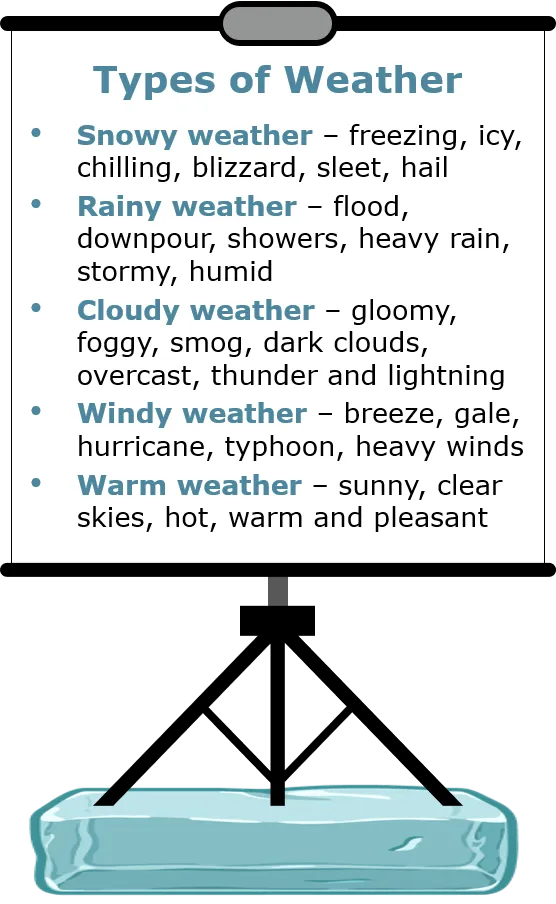
Part 2: Sample Answer
Right, so I kind of like all the weather, depending on the situation. For instance, I enjoy mild sunny weather for traveling, having a walk, spending time in a park and so on. I feel quite relaxed and peaceful when it rains , but only if it’s my day off. If I have to go out, I’d hate it for sure. So as you can see , my feelings about the weather are all about the situations I’m in. I will tell you about one type of weather that I enjoy and actually really miss at the moment – snowy winter weather .
A short introduction about my favorite types of weather.
When I talk about snowy weather, of course , I don’t mean a snowstorm or a blizzard . What I mean is a temperature below zero , but not lower than minus five , and everything already covered in a beautiful white blanket of snow . The temperature is important because I really hate it when the snow melts in your feet and everything leaks . Below zero keeps the snow soft and intact .
Explaining exactly the type of weather I will talk about.
I usually see this kind of weather back in my hometown or up in the mountains at some winter ski resort . I’ve been to those ski resorts many times, and although I don’t particularly enjoy skiing , I still do it every time I have the chance. What I love the most is to dress up in my winter suit and explore nature . In the city I’d usually go to the park at night. As everything is white, the park is lighted up and you can’t recognize that it’s night. Up in the mountains, I’d hike in the forest or even try to climb up a hill or a mountain peak . It’s really exciting to do that, although if there is a lot of snow, it’s quite difficult to walk up or down as you might slip a lot. Other than that, I build a snowman (yes I’m grown up, I know), or even just jump in the snow. That’s how much I enjoy it.
Answering where can I see it? What activities I like and dislike to do in it?
The reason I like it is simple – the snow changes the whole outlook of a city or a mountain. It’s like seeing your surroundings in a completely new way. A person can take many funny photos, enjoy many different winter activities and there is simply no way to hate this kind of weather. I really miss it to be honest.
Giving a few reasons why I like or enjoy the weather plus some more activities.
Sentence starters and Linking words
Vocabulary related to the topic, part 3 questions.
In this part we continue to discuss the topic of weather with further questions about seasons, clothes to wear, impact on people and festivals related to weather. Lets take a look.

Examiner: What do people wear in different weather?
Consider seasons.
- We wear different clothes in different seasons - Spring, Summer, Autumn, Winter.
- Clothes' types and style are almost the same all around the world for the different seasons. Just name 10 different ones in different time.
Consider weather
- You can mention a few different weather types - sunny, windy, snowy, rainy, and maybe an extreme weather like a snow storm or a pouring rain .
- Again you can mention just a few types of clothing we wear in those times.
Examiner: What are people’s opinions on the weather forecast?
Consider do people believe the forecast.
- You can compare with the past. In the past the weather forecast used to be unreliable. However today its quite accurate.
Consider in your family
- Are there people from your family (parents or grandparents) who do not believe the forecast on the internet or on TV? You can say something about that.
Examiner: How does weather influence people’s life?
Consider different jobs.
- There are many jobs that get impacted from the weather. These are for example farmers , construction workers , drivers , delivery workers , and so on.
Think about personal plans
- We arrange personal plans depending on the weather.
- If we have a beautiful sunny day we might do outdoor sports , hiking, walks along the beach and so on. If not then we usually cancel all plans and stay at home.
Examiner: Are there any festivals about seasons?
Think about local festivals.
- Many countries have small, local festivals related to spring, flowers and nature returning back to normal after winter.
Any international festivals?
- The most common ones to think about would be Thanksgiving which celebrates the harvest , or the Winter and Summer Solstice (longest and shortest day in the year).
Part of the answer is for China as I live here at the moment:
Well, yes of course . Here in China, we have Spring festival and Mid-Autumn festival . These two are sort of at the beginning of those seasons. Of course, sometimes they don’t match exactly , but we know that spring brings a new beginning , same as Spring festival brings the Chinese New Year. If we look abroad , in America they have Thanksgiving which is related to the harvest and collecting the yield from the harvest. At least that’s how it began and now it changed and turned to be a family gathering festival . And then there are the Winter and Summer Solstice festivals , which are a bit forgotten these days , but they represent a celebration of the longest and shortest day in a year.

Weather Forecast Report Sample Script in English
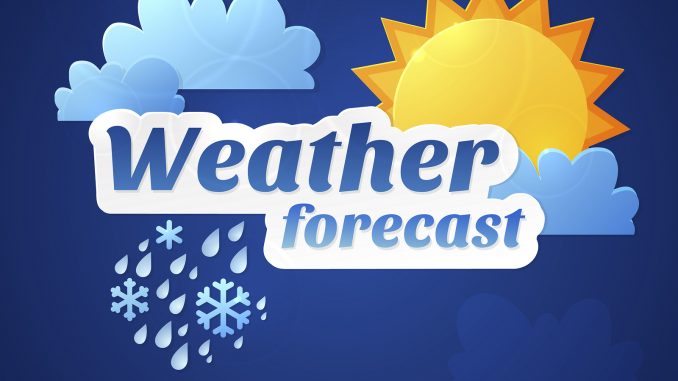
A weather forecast can be defined as, “ A written or spoken statement describing what the weather has been like recently, what it is like at the moment, or what it will be like for a period in the future. ” or “A daily report of meteorological observations, and of probable changes in the weather; esp. one published by government authority”.
A weather report is a bit technical as compared to other report writing you have been practicing earlier. You need to choose words and phrases correctly and present the information gathered in the language of meteorologists.
Weather report writing has its own format which is precise, to the point, and delivers facts and predictions right on hand. A weather report article or analysis typically includes a statement of current weather conditions along with a weather forecast for the next 24 hours.
Following is the weather forecast report sample script in English which includes important information elements included in a typical weather analysis report:
Also Read: Newscasting Script for The Introduction
Weather Report 1:

Welcome to the weather forecast. Now, let’s see what the weather is like today. In the north of the country, it’s very windy and cold. There is a chance of some rain too, so don’t leave home without your umbrella! The temperature is around 10º centigrade. In the east it’s rainy all day today, I’m afraid. There may be a thunderstorm in the afternoon. The temperature is a bit higher, at around 13º.
In the west and middle of the country, the weather is dry but cloudy. So no rain for you, but it is quite windy and the temperature is just 10º. The south of the country has the best weather today. It’s cloudy most of the time but sunny this afternoon. The temperature is around 15º.
Weather Report 2:
Hi, I’m ____________________________, your weather presenter. I will be covering your local weather in ___________________________, __________________________. The current condition is… Looking ahead, your 3-day forecast consists of… a ___________________ day for Monday. There will be a high of __________________ (weather conditions) (high temp) and a low of ____________________. (low temp) Tuesday, it will be a ____________________ day. There will be a high of ___________________ (weather conditions) (high temp) and a low of ____________________. (low temp) Wednesday will be a ____________________ day. There will be a high of ________________ (weather conditions) (high temp) and a low of ____________________. (low temp) Thursday should be a __________________ day. There will be a high of _________________ (weather conditions) (high temp) and a low of ____________________. (low temp) Friday, we’re looking at a__________________ day. There will be a high of _______________ (weather conditions) (high temp) and a low of ____________________. (low temp) that’s your weather forecast, thanks for watching! I’m _________________________, now back to _______________ and _________________.
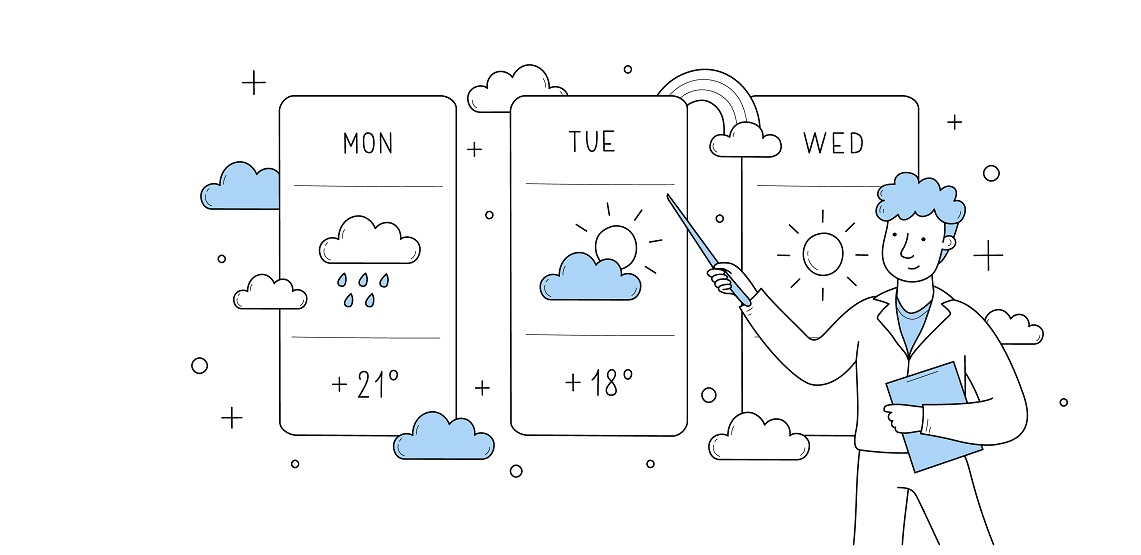
How to Write a Summary of a Newspaper
Weather report 3:.
Forecast For Friday 05/18/20XX The maximum temperature today is near 86 degrees. A partly cloudy and warm day is expected. The lowest relative humidity is near 33 percent. Expect 13 hours of sunshine, which is 87 percent of possible sunshine. Average winds will be Northeast at 8 MPH during the morning and Northeast at 9 MPH during the afternoon.
Forecast For Saturday 05/19/20XX The minimum temperature is near 58 degrees. Maximum temperature near 83 degrees. Mostly sunny and dry to start the weekend. The lowest relative humidity is near 30 percent. Expect 15 hours of sunshine, which is 100 percent of possible sunshine. Average winds will be Northeast at 9 MPH during the morning and Northeast at 9 MPH during the afternoon.
Forecast For Sunday 05/20/20XX The minimum temperature is near 58 degrees. Maximum temperature near 85 degrees. A dry weather pattern will continue. The lowest relative humidity is near 30 percent. Expect 15 hours of sunshine, which is 100 percent of possible sunshine. Average winds will be Northeast at 7 MPH during the morning and Northeast at 6 MPH during the afternoon.
Forecast For Monday 05/21/20XX The minimum temperature is near 58 degrees. Maximum temperature near 88 degrees. Isolated showers will be possible afternoon, averaging < 0.10 inches. The lowest relative humidity is near 29 percent. Expect 14 hours of sunshine, which is 93 percent of possible sunshine. Average winds will be Southwest at 3 MPH during the morning and Northwest at 4 MPH during the afternoon.
Forecast For Tuesday 05/22/20XX Minimum temperature near 62 degrees. Maximum temperature near 86 degrees. Slightly greater coverage of showers is forecast, averaging < 0.10 inches. The lowest relative humidity is near 38 percent. Expect 13 hours of sunshine which is 87 percent of possible sunshine. Average winds will be Southwest at 5 MPH during the morning and West at 7 MPH during the afternoon.
Weather Report 4:
Partly cloudy in the evening, becoming cloudy overnight. Low around 55 F. Winds S at 5 to 10 mph Sun may give way to rain for this evening, with a 10 percent chance of precipitation and a low of 50 degrees. Winds are expected to remain calm at 9 mph.
Clear with cloudy periods; a slight chance of showers or thundershowers. Mostly clear with showers likely. Slight chance of a thunderstorm. 3 to 6 mm of rain.
Newscasting Opening and Closing Script Lines
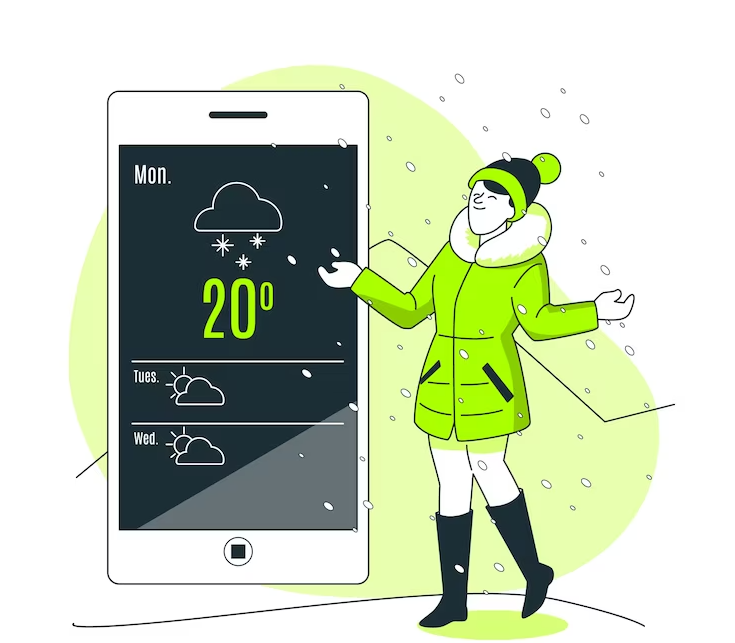
Typical Weather Report Format
The following are the important information elements included in a typical weather analysis report:
- Stn: Station ID
- Temp: Present temperature (°C)
- MinT: Minimum temperature (°C) recorded over the last 18 hours
- MaxT: Maximum temperature (°C) recorded over the last 18 hours
- RH: Present RH (%)
- WndDir: Wind direction
- WndSpd: Wind speed (km/h)
- WndGust: Wind gust (km/h)
- Rain_mm: Rain since the last report (mm)
- Snow_cm: Snow since the last report (cm)
- Hail_mm: Hail since the last report (mm)
- FFMC – Fine Fuel Moisture Code
- ISI – Initial Spread Index
- DMC – Duff Moisture Code
- BUI – Build Up Index
- DC – Drought Code
- DSR – Daily Severity Rating
- FWI – Fire Weather Index
The weather forecast you mention in your report must be for three or seven days. Do not forecast the weather conditions for months because long-term forecasts are less accurate and, therefore, less reliable. The forecast can be made by studying the satellite map or taking the help of meteorologists.
When writing a weather forecast, you need to state the general weather conditions such as sunny, cloudy, rainy, stormy, cloudy, low and high temperature, and weather warnings like tornadoes, flooding, etc.
Related Articles:
- How to Prepare a Report for News
- English Vocabularies and Phrases Related to Newscasting & Media
- How to Write a News Report | The Basic Steps of News Writing
- News Broadcast Script Sample for Students
Share this:
- Click to share on Facebook (Opens in new window)
- Click to share on Twitter (Opens in new window)
- Click to email a link to a friend (Opens in new window)
- Click to share on LinkedIn (Opens in new window)
- Click to share on Pinterest (Opens in new window)
Related posts
Learning english through culture: exploring language in context, comparing script for annual function at school, college or university, how to learn the english language through news channels, 12 comments.
I am genuinely happy to glance at this weblog posts which carries plenty of helpful information, thanks for providing these kinds of statistics.
I am glad the information helped you.
Good Weather report thanks.
Thanks, for the appreciation and glad it helped you.
Superb. thank you very much
thank you much this help me out
Thanks for the feedback.
great information on how to present the weather. I am in Western Australia, and I am wheelchair bound. I have found these articles very helpful for me to learn from.
Thanks for the feedback Sean.
It is very important.thank you very much
Thank you for this useful information with us.
Great post! I found the weather forecast report sample script in English very helpful. I’m going to use it as a reference for my own weather reports. Thank you for sharing!
Leave a Comment Cancel Reply
Save my name, email, and website in this browser for the next time I comment.
The shortest time frame in which our writers can complete your order is 6 hours. Length and the complexity of your "write my essay" order are determining factors. If you have a lengthy task, place your order in advance + you get a discount!
Finished Papers
Customer Reviews

IMAGES
VIDEO
COMMENTS
4. Conserving water to reduce the amount of energy needed to pump and treat it. Conclusion. Weather is an important part of our lives and can have a big impact on our mood, health, and ability to function properly. There are four main types of weather: sunny, cloudy, rainy, and snowy. Each type of weather has its own set of benefits and ...
Essay # 2.Elements of Weather and Climate: . Weather refers to the sum total of the atmospheric conditions in terms of temperature, pressure, wind, moisture, cloudiness, precipitation and visibility of a particular place at any given time.
This one's 160+ Ways to Describe Weather. A note: These are for inspiration only. They can't be copied because they've been pulled directly from an author's copyrighted manuscript (intellectual property is immediately copyrighted when published). Evening. Evening shadows deepened into blue and purple.
WIND . like a blast from a hair dryer. icy blast. a gust of wind. wild wind. raw wind. stiff wind. insistent winds. heavy winds. strong winds. ... — but it is a weather phenomenon, namely a tornado, that brings them together. So the description of the sky and the weather is quite detailed in places (specially as the supercell storm roars down ...
These are some of the weather descriptions written by our P1 and P2 students: "It was a cool and breezy evening. A strong gust of wind blew against my face.". "It was a bright and sunny morning. White, fluffy clouds drifted across the sky.". "Lightning flashed across the sky. A storm was coming.". Short.
Onomatopoeic verbs and words are perfect for describing the weather because they make a sound.. Here are a few examples to illustrate sound words. The pitter-patter of raindrops.. Thunder rumbled overhead.. Light hail pinged on the window pane.. With each step, the fresh snow crunched underfoot.. A bolt of lightning cracked across the night sky.. A cold north wind hissed through the trees.
Wind and Weather. As a result of the movement of atmospheric materials transported by wind, driven by the energy from the sun, climates are created and weather occurs. Without wind, weather would not exist. Wind, in its interdependent relationship with the other cycles of the Earth, like ocean currents, is the vehicle by which water vapor and ...
250 Words Essay on Weather Introduction. Weather is an integral part of our daily lives, influencing our activities, moods, and overall wellbeing. It is the state of the atmosphere at a specific time and place, characterized by parameters like temperature, humidity, wind velocity, and atmospheric pressure. The Science of Weather
Write a daily weather report. Students need to have a diverse vocabulary to describe the weather. If your teacher gives you instructions to write about the weather, you'll need to have some weather words ready to describe it accurately. Our 25 weather writing prompts will help you create word banks for describing it that you can use in future ...
In warm weather, the wind can feel refreshing and invigorating, carrying with it the scent of blooming buds and the warmth of the sun. Words such as "invigorating," "refreshing," and "balmy" can be used to describe this wind. Overall, there are many ways to describe the wind depending on the season and weather conditions.
03 Light breeze. A light breeze has a force of 2 and wind knots of 4 to 6. This is enough for you to feel the wind on your face and for wind vanes to move. There is a very light, almost quiet rustling of leaves, and at this point, small wavelets begin to form; however, there is no breaking. 04 Gentle breeze.
Essay on Weather; Paragraph on Weather in 250 Words. Weather is what we feel outside, like if it's sunny, rainy, windy, or snowy. It changes a lot and can be different in different places. We have seasons like summer, winter, spring, and fall because of how the weather changes throughout the year. Sometimes the weather can be nice and warm ...
Weather radar, wind and waves forecast for kiters, surfers, paragliders, pilots, sailors and anyone else. Worldwide animated weather map, with easy to use layers and precise spot forecast. METAR, TAF and NOTAMs for any airport in the World. SYNOP codes from weather stations and buoys. Forecast models ECMWF, GFS, NAM and NEMS
Example: "The fierce wind shook the window panes, a testament to the storm's power.". Wild: Wild wind suggests a sense of chaos and lack of control. Example: "The wild wind tossed the ship like a toy, waves crashing over the deck.". Gusty: Gusty winds are strong and sudden, capable of causing brief moments of disarray.
Use a comparative adjective here to compare the weather now with another time in the past. You could use other comparative adjectives like colder or less windy. The Difference Between Weather vs. Climate vs. Temperature. In English, the words "weather," "climate" and "temperature" usually aren't interchangeable.
33 Writing Prompts about Weather. Whether or not you enjoy small talk, you have to admit that the weather is important and affects our everyday lives. We experience many types of weather on Earth, from hot and sunny days to snow-covered nights, and everything else in between. Rain or shine, these writing prompts aim to help get your brain ...
Essay on Winds. Essay # 1. Planetary Winds: These winds move in one direction throughout the year. They move from high pressure areas of major pressure belts to low pressure areas. These winds are also known as stable winds. Eastern or Equatorial winds, Trade winds, Western winds and Polar winds are examples of these winds.
Windy Day (Essay Sample) August 22, 2017 Essay Samples, Free Essay Samples. Wind comes with varied speed in an area and depending on different factors. For instance, the wind is likely to be at high speed in a bare land without trees. Some regions also experience high speeds of wind compared to others. The Wind blows hard as trees bend over.
Words Describing Cold Weather. bleak - very cold and grey. biting - so cold that it makes you feel uncomfortable. brisk - fairly cold and a fairly strong wind is blowing. crisp - cold and dry. fresh - fairly cold and the wind is blowing. frosty - cold enough to produce frost. hard - a very cold winter. harsh - extremely cold and ...
You can mention a few different weather types at the beginning and then discuss one. Most people would talk about sunny, warm weather, but there are other options that we like depending on what we do.A lot of people love snowy weather, but not a snow storm.Many like windy weather but not a hurricane.; Try to think about many activities you and other people could do in that weather.
Weather Forecast Report Sample Script. A weather forecast can be defined as, "A written or spoken statement describing what the weather has been like recently, what it is like at the moment, or what it will be like for a period in the future." or"A daily report of meteorological observations, and of probable changes in the weather; esp. one published by government authority".
The most common way to use "windy" is as an adjective. As an adjective, "windy" describes or modifies a noun, providing additional information about its characteristics. For example: The wind was strong and windy during our hike. She tied her hair up in a bun to prevent it from flying around in the windy weather. 2.
Windy Weather Essay - Harry. Create new Account. Niamh Chamberlain #26 in Global Rating Visit the order page and download the assignment file. 4.8/5. Windy Weather Essay: Level: College, University, High School, Master's, PHD, Undergraduate. harriz 481 100% Success rate ...
A wind deflector at the top edge of the windshield deploys, kicking airflow up and over the passenger cabin. A clever bit of aerodynamics. AMG high performance brake system features 14.6 x 1.4 ...